



Digital infrastructure of tomorrow, today





Digital infrastructure of tomorrow, today
K2 Strategic is a global developer, owner, and operator of hyperscale digital infrastructure assets.
We specialise in delivering the critical physical infrastructure that underpins today’s internet, cloud services, and emerging digital technologies. From advanced data centre environments to renewable energy and connectivity solutions – we are a comprehensive digital infrastructure partner.
DATA CENTRES (PORTS)
DATA CENTRES
State-of-the-art hyperscale campuses across Ireland, Thailand, Malaysia, and Indonesia — engineered to support the evolving needs of global enterprises.
World-class data centre campuses in Ireland, Indonesia, Malaysia, and Thailand — purpose-built to meet the dynamic demands of global hyperscalers.




Extending our reach beyond data centres, we invest in regional connectivity infrastructure to ensure seamless, secure data exchange across international markets.
Driving sustainable innovation through renewable energy solutions that power our data centres in strategic global markets. RENEWABLE ENERGY



CIRCULATION: 18,000
ONLINE READERSHIP: 410,000 monthly unique clicks through Google Analytics
The SingaporeBusinessReview is the highest circulating and best read business magazine in Singapore. Our online readership has an average of 215,000 unique viewers, according to Google Analytics. We won the Business Trade Media of the Year Award at the 2017 MPAS Awards.
Do reach out to us if you would like us to tell your story to our readers via print and online advertising or events.
PUBLISHER & EDITOR-IN-CHIEF Tim Charlton
EDITORIAL MANAGER Tessa Distor
PRINT PRODUCTION EDITOR Eleennae Ayson
LEAD JOURNALIST Noreen Jazul
JOURNALISTS Diana Dominguez Frances Gagua
Vincent Mariel Galang
Alec Maquiling-Cruz
Marielle Medina Jaleen Ramos Olivia Tirona
EDITORIAL RESEARCHER Angelica Rodulfo
GRAPHIC ARTIST Simon Engracial
EDITORIAL ASSISTANT Vienna Verzo
COMMERCIAL MEDIA TEAM Jenelle Samantila Dana Cruz Danielle Goh
ADVERTISING CONTACTS Shairah Lambat shairah@charltonmediamail.com
AWARDS Julie Anne Nuñez-Difuntorum awards@charltonmediamail.com
ADMINISTRATION Eucel Balala accounts@charltonmediamail.com
EDITORIAL sbr@charltonmediamail.com
SINGAPORE
Charlton Media Group 101 Cecil St. #17-09 Tong Eng Building Singapore 069533 +65 3158 1386
HONG KONG Room 1006, 10th Floor 299 QRC, 287-299 Queen's Road Central, Sheung Wan, Hong Kong +852 3972 7166 www.charltonmedia.com
MIDDLE EAST
FDRK4467, Compass Building, Al Shohada Road, AL Hamra Industrial Zone-FZ, Ras Al Khaimah, United Arab Emirates
PRINTING
Times Printers Private Limited 18 Tuas Avenue 5, Singapore 639342 www.timesprinters.com a member of Times Publishing Limited
Editorial Enquiries: If you have a story idea or press release, please email our news editor at sbr@charltonmediamail.com. To send a personal message to the editor, include the word “Tim” in the subject line.
Media Partnerships: Please email sbr@charltonmediamail.com with “Partnership” in the subject line.
Subscriptions: Please email subscriptions@charltonmedia.com.
Singapore Business Review is published by Charlton Media Group. All editorial materials are covered by copyright and may not be reproduced without consent. Contributions are invited but copies of all work should be kept as Singapore Business Review can accept no responsibility for loss. We will, however, take the gains.
Sold on newsstands in Singapore, Malaysia, Hong Kong, London, and New York. Also out in sbr.com.sg with an online readership of 215,000 monthly unique visitors*.

Institutional investors are pivoting to alternative assets like worker dormitories, fuelled by Singapore’s booming construction sector. Learn why worker dormitories are a strong investment, and which other assets are attracting investor interest in our cover story on page 24.
A shift is also taking place in the private equity landscape as fund managers redirect their focus towards resilient, impact-driven sectors such as healthcare and education. Experts note a renewed sense of optimism in the PE market, buoyed by the Singapore Exchange’s efforts to revitalise listings. Read the full story on page 18.
The Singapore Exchange has also seen a wave of new listings this year, including NTT DC REIT and Info-Tech Systems. We spoke with the leaders of these companies to learn what’s next for them following their Singapore debut. Read more on page 50.
Another CEO we were able to speak with is Realion Group’s Desmond Sim, who offered insights on why building a unified proptech platform is critical to the industry’s digital transformation. Read more on page 52.
Sim’s call for digital transformation resonates strongly with Singapore’s real estate agents, who are now pushing for greater digitalisation and standardisation of property data across the sector. Find out more on page 32.

Tim Charlton
Business Review is a proud media partner and host of the following events and expos:




Business Review is available at the airport lounges or onboard the following airlines:
Singapore Business Review is available at the following clubs and hotels:


*Source: Google Analytics





Co-creating Singapore’s first ‘Borderless University’ with StarHub’s Ubiquitous Network.
StarHub and the National University of Singapore (NUS) have co-created Singapore’s first ‘Borderless University’, a breakthrough initiative that is reshaping the future of education.
The ‘Borderless University – Powered by Infinite Technology’ initiative leverages StarHub’s modern digital infrastructure, powered by Cloud Infinity — a hybrid multi-cloud architecture – to deliver ultra-fast, secure, and uninterrupted connectivity for staff and students anytime, anywhere, both in Singapore and abroad.
At the heart of this initiative is a private 5G network exclusively built by StarHub for NUS — a first-of-its-kind in Singapore. Using eSIM technology, students and staff can instantly and securely connect to NUS’s digital resources and the internet without the need for physical SIM cards, complex configurations, or VPNs.
A simple QR code scan is all it takes.
Leveraging 5G backhaul technologies, the solution also ensures seamless connectivity even for devices that are not 5G-enabled. By integrating directly into NUS’s existing network, it fosters a truly mobile, flexible, and borderless learning environment from lecture halls to living rooms.
“The 5G network has completely transformed how I learn at NUS. I can seamlessly access study materials, quizzes, and exams anytime, whether I’m on campus or at home. With secure and reliable connectivity, I can take exams or complete assignments on the go confidently using my 5G-enabled PCs or
devices without disruptions. This convenience has also significantly boosted my productivity, saving me about three hours each week. The extra time has allowed me to focus more on my studies,” said Year 3 Faculty of Dentistry student, Chua Sim Ying.
The Borderless University is not just a leap forward in connectivity — it is a stride towards building a greener, smarter campus.
By potentially reducing the need for physical cabling and wired infrastructure, StarHub’s solution supports NUS’s efforts to lower its carbon footprint and create a greener digital ecosystem.
The network was rigorously tested with NUS focus groups to ensure optimal performance, security, and user experience — reflecting StarHub’s commitment to delivering human-centric innovations that align with NUS IT's mission to drive the New Digital for

“This collaboration with StarHub aligns with our vision for a future-oriented learning environment. Both staff and students will benefit from seamless access to NUS’s resources and the internet, wherever they are in Singapore; and in the future, overseas, without the need for VPN or other remote access technologies” — Ms Tan Shui-Min, Chief Information Technology Officer, NUS
StarHub’s partnership with NUS was recently recognised at the SBR Technology Excellence Awards 2025, where the project won the Connectivity – Telecommunications category.
The accolade celebrates the bold reimagining of what a campus network can be — borderless, intelligent, and future-proof.
“Partnering with the National University of Singapore to co-create Singapore’s first Borderless University has been a truly exciting journey. This award reflects not just the strength of our collaboration, but the real impact that StarHub’s Modern Digital Infrastructure can deliver. By combining secure, seamless connectivity with future-ready innovation, we’re helping to set a new standard



3
FairPrice Group has announced the return of its Save Every Day campaign, this time featuring over 100 SG60 edition vouchers as part of Singapore’s 60th anniversary celebrations. Running from 12 June to 10 September 2025, the campaign offers customers more than $1,000 in savings through over 400 unique In 2024, the campaign generated nearly $1.4m in customer savings.

What today’s C-suite can learn from tomorrow’s leaders
BY Tom Murray
In a world defined by rapid technological change, evolving workforce expectations, and complex global challenges, standing still is not an option – especially for those at the helm. Business leaders today are not only expected to respond to disruption, but to anticipate it and adapt with it. In Singapore, Gen Z already makes up 16% of the workforce as of 2024.
Three in five workers in Singapore, or 60%, lived paycheck to paycheck in 2024, surpassing the Asia-Pacific average of 48%, according to ADP’s People at Work 2025 report. More than a quarter of the participants, or 26%, held multiple jobs to cover basic expenses, manage additional costs, or save for retirement. Some also cited the need to gain work experience for taking on extra work.

Mobile-first web design: Why Asian brands can't afford to ignore it in 2025
BY Dhawal Shah
Over 90% of Singaporeans own a smartphone, and mobile devices account for more than 70% of all web traffic in the country. Across Asia, mobile is no longer just another channel, it’s the primary gateway to customers. Mobile-first web design is not just best practice, it is a survival strategy. Ignoring mobilefirst web design could mean missing out on your most valuable audience.

elite art buyers
Auction houses like Sotheby’s, Christie’s, and Bonhams are luring the growing pool of wealthy Southeast Asian collectors who pay top dollar for art produced by globally and regionally renowned artists. Affluent Millennials and Gen Zers have sharply increased their spending on art. They have emerged as a key clientele for international auction houses.

The economic cost of inaction on gender parity in Singapore
BY Datin Seri Umayal Eswaran
Why is progress on gender parity panels still so slow — even when we already know the solution? Despite all the data, resources, and collective brainpower dedicated to closing gender gaps, real, systemic change continues to lag. In Singapore, women make up nearly half the workforce, yet hold only 13% of chief executive roles.





















No green light for Grab: Is it time to lift the cross-border ride-hailing ban?
Analysts backed Singapore’s decision to keep a ban on cross-border private ride-hailing service with Johor Bahru, Malaysia, citing adequate options and potential risks to the local taxi industry.
Terence Fan, assistant professor of strategy and entrepreneurship at Singapore Management University, said licensed taxis are sufficient to meet the demand.
“During certain festive seasons, demand seems to outstrip current supply,” he told Singapore Business Review. “However, outside of this season, the current supply of crossborder taxis seems to be more than capable of handling the demand," he continued.
The government on 3 August said it would not open the route to private-hire cars, keeping cross-border travel limited to licensed taxis under the Cross Border Taxi Scheme, which allows about 200 taxis from each side.
The city-state is unlikely to allow ridehailing vehicles to cross the border unless alternatives can’t handle demand regularly, Fan said in an exclusive interview.
Daniel Chow, principal at Arthur D. Little Southeast Asia, said commuters already have other licensed public transport options,
including cross-border buses and the Johor Bahru–Singapore Rapid Transit System, scheduled to begin service by late 2026.
He said opening the route to private-hire vehicles could erode taxi ridership, which is already below capacity. “The decision, whilst restrictive, is justified and strategically sound from a transport policy perspective.”
Masaki Honda, vice president of mobility at Frost & Sullivan, said cross-border ride-hailing would be difficult to enforce.
“It is very complex to harmonise regulations between Singapore and Malaysia,” he said. He also told the magazine that restrictions ensure safety, keeping oversight within Singapore’s transport ecosystem.
Fan agreed that enforcement would be difficult. “How can we catch nonconforming vehicles or drivers if they are out of Singapore, or if they are in Singapore for only a short amount of time?” he asked.
Timothy Wong, a senior economics lecturer at the National University of
Singapore, emphasised the importance of keeping safety and driver standards.
“If Malaysian cars are allowed to provide trips into Singapore and return to Malaysia with passengers, our safety and driver standards should still be upheld,” he said in a separate interview. Lowering these standards, he added, could undermine consumer confidence in ride-hailing services.
Fan said letting private-hire operators work across the border could draw more drivers away from taxis, given lower rental costs and greater flexibility. Singapore’s taxi fleet had fallen to 12,261 as of July from 13,343 a year earlier, whilst the number of private-hire cars rose to 93,966 from 85,881.
Restricting cross-border access helps protect the taxi sector, he said. “It creates reasons for taxi drivers to feel that at least, some of their business is protected.”
Chow said local taxi firms, even those with their own booking apps, would be disadvantaged compared with regional players such as Grab, which could more easily use cross-border networks.
He also noted that Malaysian operators benefit from lower fuel and maintenance costs, whilst Singapore’s stricter licensing raises compliance expenses.
The Frost & Sullivan expert warned that liberalisation could see Malaysian drivers offering lower fares, leading to “significant trip losses” for Singaporean drivers.
The Land Transport Authority said it is working with Malaysian counterparts to improve the Cross Border Taxi Scheme, including measures like introducing appbased bookings for licensed taxis and adding more boarding and drop-off points.
Cross-border taxis can only operate between Ban San Street Terminal in Singapore and Larkin Sentral in Johor Bahru.
Honda said the quota is underused partly because of the single pick-up and drop-off point on each side. He proposed revising licensing and using platforms such as Grab or Gojek to make transactions transparent.
Wong also suggested encouraging shared taxi rides. “There might be many people who are willing to share a ride to get across the border, and to some extent, the authorities may want to encourage that,” he said.
Allowing more taxis without promoting ride-sharing could worsen congestion, he said. “If two people from a similar location in Singapore are heading to a similar location in Johor Bahru, you should incentivise them to share a taxi for that trip," Wong added.
The decision, whilst restrictive, is justified and strategically sound from a transport policy perspective

Reverie on the Hill (ROH), Singapore’s first creator-led retail concept at Dempsey Hill, aims to bring in more than 500 active creators by the end of the year as it expands its product lineup and forges various brand partnerships.
“After managing millions in marketing spend for various retail campaigns, one metric stood out: authentic user-generated content and reviews consistently outperform flashy ads,” ROH founder Gene Kwok told Singapore Business Review
“At the same time, I saw how hard it is for product brands to seed authentic reviews at scale, and how creators struggle to monetise consistently,” he
Asaid in an exclusive interview.
ROH, a boutique skincare studio and creator-powered retail space, was built around the idea that authentic, user-generated content is more powerful than traditional advertising. Launched in July, the store provides personalised facial treatments, including deep-cleansing facials, barrier-repair therapies, and noninvasive skin care services.
It combines physical retail with immersive digital engagement, offering a space where creators can test products, share feedback, and earn rewards for participation.
For brands, the model provides a way to enter the market without
bout 41% Singapore businesses plan to freeze wages in the next 12 months, up from 35% last year, as economic uncertainty weighs down confidence and hiring plans, according to the Singapore Business Federation’s (SBF) National Business Survey 2025 – Manpower and Wages Edition.
Fewer companies intend to raise salaries, with 59% planning increases compared to 64% last year. The only exception is for lowerwage workers, with two in three firms still planning to increase their pay.
The overall business sentiment index dipped 1.1 points from 56.5 in the first quarter of 2025 to 55.4 in the second quarter.
At least 35% of companies expect conditions to worsen in the year ahead, whilst only 14% see improvement.
Many are holding back on hiring, with

hefty listing fees, whilst for shoppers, it promises a “more authentic, community-driven way to discover products,” Kwok said.
ROH accepts creators of all sizes, from nano to established influencers, through applications on its website. “There is no minimum follower count because we believe everyone has a sphere of influence,” Kwok said.
Accepted members get access to curated product drops, discounts, affiliate commissions, and brand collaborations. The retail store operates on a tiered membership system: the Storyteller tier offers a 20% discount for one to two approved content pieces per month, whilst the Curator tier gives 30% off for three or more monthly posts.
An invite-only Reverie Black Card will soon be introduced for top creators and tastemakers, offering exclusive benefits such as early product access, private event invitations, and partner perks.
Shoppers are also included through the Dreamer tier, which gives 5% discounts, early sale access, beauty newsletters, event invitations, and rotating “Brand of the Month” offers.
We wanted ROH to feel like a clubhouse for creators rather than just another retail shop
“We wanted ROH to feel like a clubhouse for creators rather than just another retail shop,” Kwok said.
ROH integrates digital interaction with in-store shopping. Customers can scan QR codes on products to access reviews, post content, and earn commissions when their recommendations lead to sales.
just 36% planning to expand their full-time workforce, compared to 40% in 2024.
The downturn is most evident in the hospitality sector, where the hiring outlook dropped sharply from 67.4 in the first quarter to 51.6 in the second quarter this year.
Companies in hotels, restaurants & accommodations, administrative & support services, and IT-related services are the most pessimistic, whilst the health & social services and education sectors remain relatively more upbeat, according to the SBF report.
Although concerns over US tariffs have eased, about 59% of firms still see them as negative, down from 81% in April this year—trade uncertainty and margin pressures continue to weigh on business confidence.


Law firms are seeing a surge in client demand for sustainabilityrelated advice as companies scramble to comply with tighter environmental, social, and governance (ESG) requirements.
Law firm Dentons Rodyk & Davidson LLP said more clients are seeking advice on carbon projects and international trade, where compliance with overseas rules is considered critical.
“Those impacted by commercial considerations, like businesses investing in carbon projects or involved in international trade… are the sectors most actively seeking sustainability legal assistance,” Jean Nie Ho, a partner at Dentons Rodyk and head of its ESG practice, told Singapore Business Review in an interview.
The city-state's sustainability legal service market is expected to grow 10% annually to as much as $500m by 2033 from 2023, according to a study published by PwC Singapore.
Key drivers and challenges
The report cited key drivers such as Singapore’s Green Plan 2030, the 2050 net-zero target, and the Carbon Tax Act, along with the implementation of Article 6 of the Paris Agreement, all of which create new compliance requirements for businesses.
These shifts have generated more work for law firms, particularly those advising on carbon tax, emission projects, and regulatory alignment.
Despite the growth outlook, PwC highlighted hurdles for law firms. Gaps in technical expertise, strong competition from international players, and client pressure to keep fees low remain major challenges.
The study found most lawyers know sustainability concepts but lack formal technical training for complex ESG work. PwC said clients want advice blending legal and commercial insight, though cost still influences their choice of counsel.

Arevision to Singapore’s seller’s stamp duty (SSD) rules that extends the minimum holding period for residential properties from three to four years is expected to dissuade short-term investors and complicate exit strategies for some buyers, analysts said.
“Condo construction periods are typically three to four years, and the extension of seller’s stamp duty to four years would likely dissuade investors who are only interested to hold and sell after three years,”
Wong Xian Yang, head of research for Singapore and Southeast Asia at Cushman & Wakefield, told Singapore Business Review
The rule change, which took effect on 4 July, raises seller's stamp duty rates by four percentage points for each tier of the holding period.
For residential properties sold within twelve months of purchase, the rate increased to 16% from 12%. For those sold after a year but within two years, the rate rose to 12% from 8%.
Units sold after two years but within three years now incur an 8% rate, up from 4%, whilst a 4% rate applies to
properties sold after three years but within four years—previously exempt.
Wong noted that investors who prefer not to rent out their units are the most likely to be affected, though he said they form only a “minority.”
“Most investors are likely to hold on for an additional year rather than deter them from investing in the private residential market, as they remain optimistic about its long-term prospects,” he added.
Wong expects the revised SSD to affect Singapore’s subsale market, where original buyers sell their units to second buyers before completion.
Subsales reached 321 units or 4% of total residential transactions in the first quarter, down from 9% a quarter earlier. They made up 11% to 13% of transactions from 2007 to 2009, the C&W head of research added.
Realion Group Chief Executive Officer Desmond Sim expects subsales to dip below 5% of total residential sales after the SSD revision.
However, Wong said some level of subsale activity might continue in the near term since the change only applies to transactions from July 2025 onward.


“Barring a sharp rise in property prices over the next few years, subsale levels are likely to fall over time as most would hold on for an additional year to avoid paying SSD," he told the magazine.
Sim said subsales and property flipping—often seen as speculative activity—could distort the market.
“When a person flips a property for profit, that will distort prices and add to the price growth that the government is targeting,” he said in an interview.
Beyond inflating prices, excessive speculative activity could also “squeeze out genuine buyer-occupiers,” Wong told Singapore Business Review.
Tricia Song, head of Research, Southeast Asia at CBRE, said the measure will curb investors who may be eyeing to replicate shortterm flips, making them think twice before buying if they can’t hold the property for four years.
Most investors are likely to hold on for an additional year rather than deter them from investing
Huttons’ Senior Director of Data Analytics Lee Sze Teck projects subsales to fall below 2% by 2026 as a direct result of the policy. He added that buyers who might have turned to the subsale market will likely shift to new launches instead, given the expected drop in subsale listings.
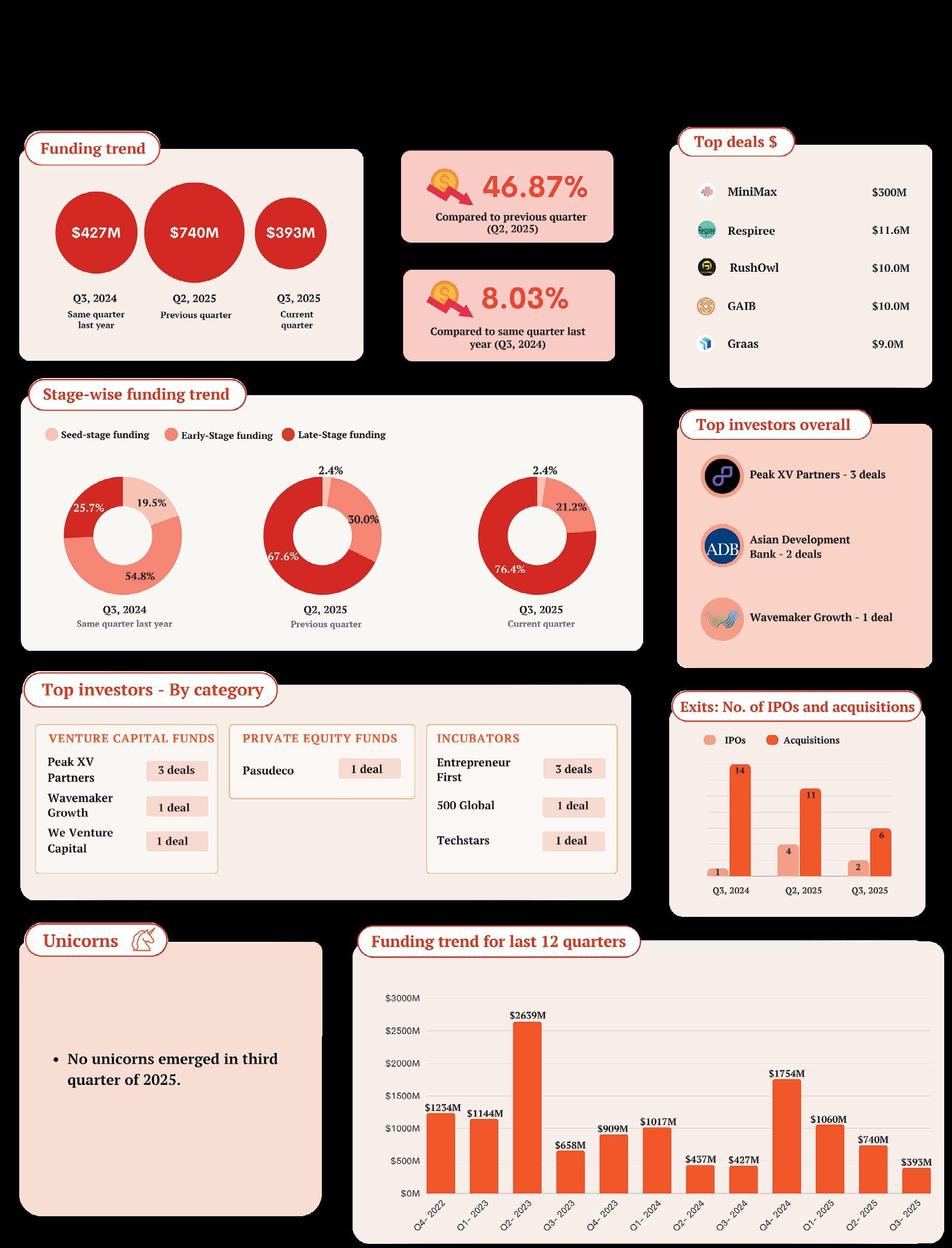

Fintech startup Seedflex Technologies Pte Ltd. seeks to facilitate lending to 50,000 micro, small, and medium enterprises (MSMEs) in Malaysia by year-end based on the enterprises' sales performance.
“Cash flow is a central part of micro and small businesses,” Seedflex co-founder and CEO Ritwik Ghosh told Singapore Business Review. “That is their asset, which has now become very widely digitised, cashless, and available for data understanding, available for credit underwriting," he added.
“We are building at the centre of that with the pay-as-yousell concept,” he said in an exclusive interview.
Seedflex’s platform, called Pay-As-You-Sell Advance, lets merchants access funding via its 12 partners, with borrowing limits and repayments based on their sales. It had 6,000 merchants in Malaysia as of June.
“It is not based on a fixed monthly repayment schedule,” Ghosh said. “If their sales go higher, they pay back faster. If sales go lower, they pay back, to a certain extent, slower.”
Sauvik Datta, co-founder and chief operating officer at the Singapore startup, said repayment occurs “almost daily,” as a share of each sale goes towards repaying the loan.
Although it helps small businesses access credit, Seedflex doesn’t position itself as a credit fintech, Datta said. Rather, it integrates into existing ecosystems that merchants already use, providing insight into their cash flow.
Seedflex plans to use the $4.1m (US$3.2m) it raised from its seed extension round early this year to to continue scaling its growth in Malaysia and to support its expansion to Indonesia. Its seed extension round was co-led by Z Venture Capital (ZVC) and Iterative, with participation from existing investor 500 Global and several strategic angel investors.
In June, Seedflex obtained registration from Indonesia’s financial services authority, Otoritas Jasa Keuangan (OJK), as an authorised provider of aggregated financial product and service information. Armed with regulatory approval, Seedflex Indonesia is moving quickly to partner with local players, expand its product portfolio, and attract new customer demographics through its OJK-backed fintech platform.
“We welcome all interested financial institutions, fintech providers, and other technology platforms to join us on this shared mission to innovate and enhance financial access and inclusion for all Indonesians,” Ghosh said.
Ghosh said Seedflex is working on features that would let merchants use credit in different ways, whether for long- or short-term financing. It is also trying to attract more merchants.
“That is the direction that we are taking—to get closer to our partners and add more value to them,” he said.
Fintech startup HeyMax, which lets travellers earn rewards seamlessly across several merchants, plans to enter Japan and Hong Kong later this year, and Korea and Taiwan by 2026 to tap into the growing travel economy.
“There's strong, organic demand globally for more travel, so we want to be able to meet our customers’ needs and to help them simplify and aggregate more travel rewards,” HeyMax CEO Joe Lu said.
The Asia-Pacific region accounts for a third of global travel volume and is also the fastest-growing market, with annual growth of 10%, he pointed out.
“The traveller economy is a force to be reckoned with,” he said in an exclusive interview. “It's really embedded in all our day-to-day life.”
“If I'm just buying a coffee, swiping a card, the card earns me miles. I am actually participating in this aggregation of my future travel,” the chief executive officer added.
The Travel Forward 2025 report by research firm Phocuswright forecasts sustained growth in the global travel market through 2026, with yearly gains of as much as 9%.

“If you’re a traveller, whether you’re based in Singapore or anywhere in the world, when you go to another market, you will also be able to earn Max Miles from local merchants, beyond online or global merchants,” Lu said.
Lu expects HeyMax users to hit a million by 2026 from 120,000 currently, and plans to double partner merchants to around 1,000.
“We have quite a lot of really enthusiastic partners in the pipeline to bring more of these consolidated and interoperable rewards and top-notch reward experiences to users,” he said.
The CEO expects double-digit revenue in US dollars by 2026.
In May, the startup said its yearly revenue was expected to top $7.7m (US$6m). It also seeks to exceed $642.4m (US$500m) in facilitated transaction volume next year from $256.9m (US$200m) in May.
ByteGenie Pte Ltd. seeks to raise $837,000 (US$650,000) to help more sales teams in the hospitality sector connect with companies and business travellers using artificial intelligence (AI) tools.
The Singapore startup had raised $515,000 (US$400,000) as of early June, Jiale Tan, co-founder and CEO at ByteGenie, told SingaporeBusinessReview
“We help corporate sales teams generate leads in real time, saving them 85% of time back for closing deals,” she said in an interview, citing feedback from a large hotel chain client. “Our AI agent can do the work of the entire data team.”
The number of qualified leads for the hotel chain also grew 10 times, she pointed out to the magazine.
“Before, sales representatives would spend an entire week manually researching

events, exhibitors, and potential customers to sell hotel rooms and venue spaces to, often ending up with only around 30 qualified leads,” Tan said.
“With ByteGenie, they can now get over 300 highly qualified leads, along with strong intent signals like what kind of events are happening, who the exhibitors are, and what specific information those exhibitors are engaging with,” she added.


Celebrating a Decade of Progress

Building Pathways for Growth

Addressing Unresolved Challenges
Secure your spot with 20% discount on your Delegate Pass
Code: SFFSMPSBR




The space is designed for certification under Green Mark, WELL, and LEED standards.
CBRE Singapore has relocated to Marina Bay Financial Centre (MBFC) after 24 years at Six Battery Road, unveiling a 21,000-square-foot office designed around data, sustainability, and well-being.
The new workspace, which is 75% larger than its previous office, is equipped with sensors that monitor air quality, occupancy, energy use, lighting, and noise levels in real time. This data-driven approach allows CBRE to improve comfort and efficiency while informing future workplace design.
Energy meters track consumption by zone, whilst dimmable lights and photocell sensors can reduce electricity use by up to 20%. Vertical hydroponic gardens


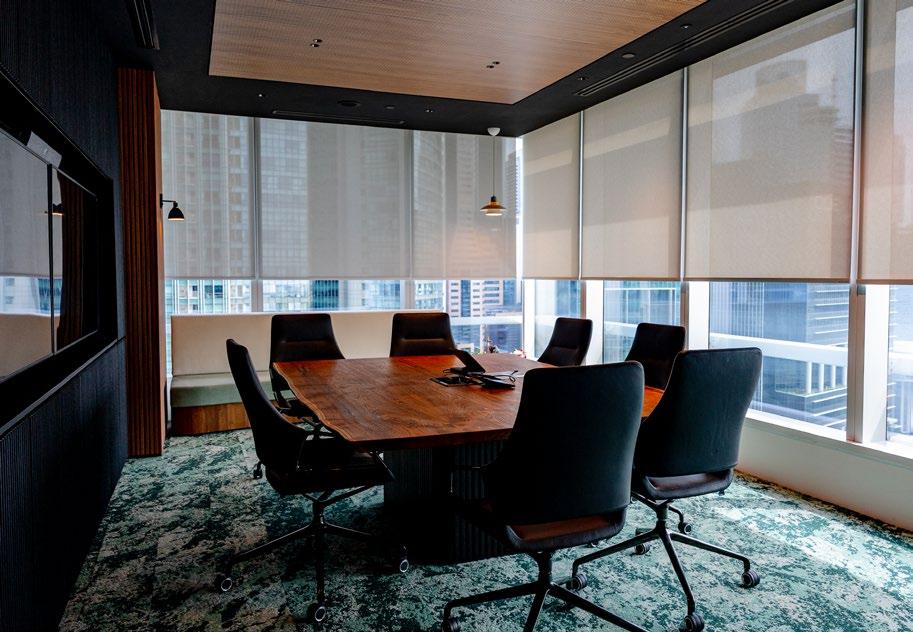

and living walls respond to air quality data, supporting CBRE’s target certifications for Green Mark Platinum, WELL, and LEED Gold.
“Some well-being-focused features include quiet workspaces to accommodate hyper-sensitive employees, as well as a social hub for those who need to be stimulated,” Moray Armstrong, CBRE Singapore’s managing director for advisory, told Singapore Business Review
The office has an in-house barista who makes freshly brewed coffee for both clients and employees.
“The Marina Bay location places us right at the heart of Singapore’s business community, allowing us to enhance our client and employee experience,” Armstrong said.



1 Stylish lobby with digital displays, showcasing CBRE’s modern and techenabled workplace design.
2 Striking emerald digital display embodies CBRE’s “Emerald of the City” concept at MBFC.
3 Sleek locker corridor supporting flexible work arrangements in CBRE’s new MBFC office.
4 Open-plan workspace with greenery, natural light, and modern design for productivity and well-being.
5 Smart meeting room with panoramic skyline views for collaborative discussions and client meetings.
6 In-house barista counter offering fresh coffee, creating a welcoming hub for clients and employees.

North Rhine-Westphalia (NRW), Germany's most populous and economically strongest federal state, is Europe's most important energy region and therefore the largest arena for the modernisation and decarbonisation of key industries. With over 170,000 greentech employees, NRW offers international companies a unique investment environment, for example, for technologies for the efficient storage, transmission and use of energy, water and recycling management.
Key to green transformation in Europe
In NRW, greentech is one of the powerful drivers of change.
The aim of NRW is to become the first climate-neutral industrial region in Europe. Mines are being transformed into recycling sites, and plasma technology is being used to turn non-recyclable plastic packaging into 100% recyclable material.
Success and profitable growth thrive where companies benefit from all the advantages of an ideal location: from innovative start-up energy and a skilled workforce to established knowledge
networks and international partnershipssuch as with Singapore.
A vibrant partnership
The links between Singapore and NRW are already strong, as both share a trade volume of EUR1.4B. Chemicals and mechanical engineering, both key elements of greentech, make up the majority of this. Singapore is one of the most important partners for NRW amongst the ASEAN economies.
Companies from Singapore, such as Green Li-ion, Aerogen, and Niessing, are already working successfully in NRW.
In NRW, you will find an excellent university and research landscape with around 70 institutions that also focus on the circular economy, water technology and resource efficiency. This means that you will find a large pool of highly qualified specialists who are entering the job market with new ideas. Business and science are mutually inspiring. For example, startups and companies from the fields of energy, sustainability and mobility come together
at the Euref Campus in Düsseldorf, which is to develop into a European energy forum. Circular Valley in Wuppertal brings together startups, established companies, science and politics to accelerate concrete solutions and the transition to a circular economy.
International greentech companies are becoming part of a vibrant innovation landscape in NRW.
Advice on the use of renewable energies in industry, apps for digital waste management, increasing the thermal efficiency of buildings by means of more accurate indoor climate data, and innovative coating technologies to make packaging recyclable – these are just some of the technologies that NRW's greentech sector is currently advancing.
Dynamic greentech location
Where so much green transformation is driving an enormously diverse business location in the heart of Europe, NRW.Global Business shows the best way forward and helps international greentech companies find their place amongst the many opportunities. You can't have everything. Except in NRW. NRW.Global Business provides you with competent and trustworthy support to explore your opportunities in NRW and build up your business.
NRW.Global Business ASEAN Service Desk
Sherena Wong Phone: +603 277 453 87 contact@nrwglobalbusiness-asean.com www.nrwglobalbusiness-asean.com

The office in Capital Square features open spaces that encourage interaction.


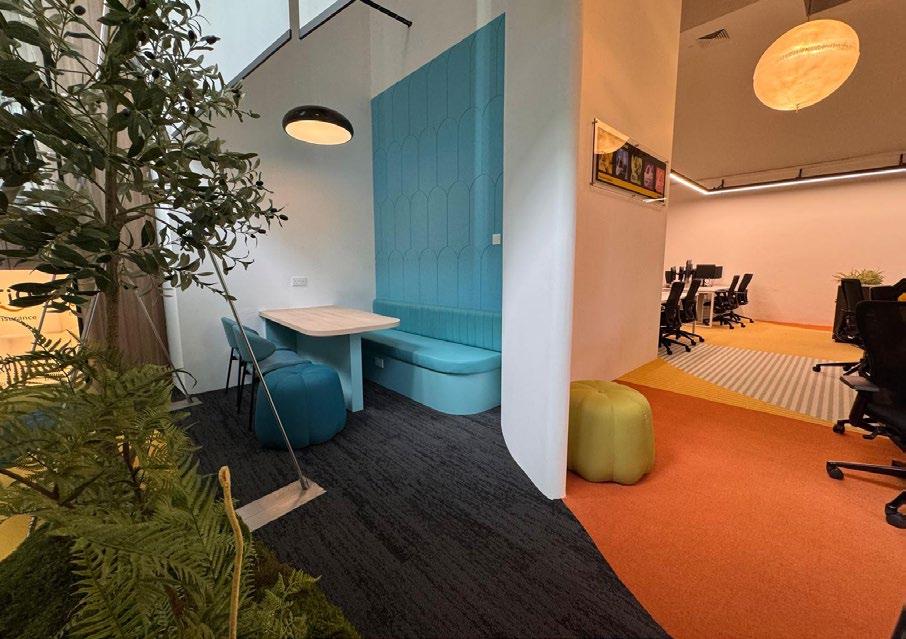
Etiqa Insurance's new Capital Square office turns its principles of protection, continuity, and customer-centricity into spatial experience.
Sphere-shaped lighting and circular planters symbolise warmth and guardianship, whilst the recurring circular motifs throughout Levels 1 and 2 echo Etiqa’s “with you” brand promise. “The lighting shaped as warm spheres near the entrance represents protection, much like a nest egg,” said Shirley Tan, chief marketing officer at Etiqa Insurance Singapore.
The ground-floor location houses the customer care centre for easier visibility and access, whilst upper floors




5 Open-space collaboration corner at Etiqa's Capital Square office.
6 Meeting room at Etiqa’s Capital Square office, designed with collapsible walls for flexible configurations.
feature open workspaces, flexible layouts, and breakout zones that encourage collaboration.
Meeting rooms with collapsible walls allow reconfiguration for town halls and larger events, supporting agility and teamwork.
The office consolidates all Singapore teams, such as operations, distribution, customer service, and digital innovation-into one environment.
Tan said the space was designed as “a meeting point for the hearts and minds of customers and staff,” reflecting Etiqa’s goal of building a connected, transparent, and human-centred workplace.




It’s also designed to enhance the health and well-being of its occupants.
Paya Lebar Green, the latest office development by Lendlease, combines sustainability, wellness, and advanced digital infrastructure as it positions itself as a premier business destination beyond Singapore’s central business district (CBD).
Tenants can optimise space use and reduce energy costs through smart Internet-of-Things (IoT) sensors embedded throughout the building, Richard Paine, head of development at Lendlease, told Singapore Business Review
“The IoT smart sensors will help the building be climateresponsive and inform tenants on occupancy and the utilisation rate of spaces,” he said in an interview.
Paine said they wanted to make the building as energyefficient in operation as it was during construction.




To minimise environmental impact during the build phase, Lendlease used biodiesel and electric-powered equipment, including battery systems for tower cranes and solar-powered lighting. The building was also built using low-carbon concrete, which traps carbon within the mix, and eco-certified finishes.
These efforts contribute to Paya Lebar Green’s achievement of the Building and Construction Authority (BCA) Green Mark 2021 Platinum-Super Low Energy certification, Singapore’s highest green building standard.
Paya Lebar Green isn’t just energy-efficient; it’s also designed to enhance the health and well-being of its occupants. It earned a WELL Core Silver pre-certification, an international standard for wellness-focused buildings.



1 Paya Lebar Green provides easy access to amenities in and around the precinct.
2 Lobby of the new 12-storey Paya Lebar Green South building.
3 Thoughtful design combining refined aesthetics and technology.
4 Paya Lebar Green North, a fully refurbished 8-storey building.
5 Smart technology for a seamless workplace experience.
6 End-of-trip facilities and shared mobility solutions encourage greener commutes. (Photos by Steve Redstone)


DEAL #1: QUADRIA CLOSED ITS THIRD HEALTHCAREFOCUSED FUND IN MAY AT $1.38B (US$1.07B)

DEAL #2: XCL EDUCATION HOLDINGS RAISED $516M (US$400M) IN A PRIVATE CREDIT FACILITY
The shift reflects resilience in a market where volatility has become the norm.
Fund managers in Singapore are steering more capital into healthcare, education, and technology as private equity firms adjust to slower exits and tighter deal pipelines across Southeast Asia.
The pivot reflects resilience in a market where volatility has become the norm, Bhavik Vashi, managing director for the Asia-Pacific and Middle East and North Africa at Carta, Inc., said.
“Healthcare provides flexibility for both buyouts and growth equity deals, making it especially appealing," he told Singapore Business Review.
Healthcare is amongst the most active private equity sectors this year, with Quadria Capital closing a $1.38b (US$1.07b) fund in May and a Temasek-backed firm acquiring a 16% stake in AC Health, the healthcare arm of Ayala Corp. in the Philippines, in August.
Healthcare accounted for 27% of Southeast Asia’s $1.29b (US$1b) deal value in the second quarter, according to Luke Pais, EY-Parthenon Asean private equity leader, said demand underpins the activity.
“Healthcare has been very active,” he said. “The driver for that is the public wants quality healthcare and people are willing to pay for it.”
He added that universal healthcare schemes in several countries have lifted sector prospects.
KPMG’s head of asset management and private equity, Andrew Thompson, told the magazine that the shift also reflects the expansion of Southeast Asia’s



middle class, which is driving long-term structural demand for healthcare and education.
He noted that as incomes rise, more households are spending on private health and training services. A 2021 United Overseas Bank report projected that 65% of Southeast Asia’s population will achieve middleclass status by 2030, strengthening the investment outlook for both sectors.
Education is steadily gaining traction alongside healthcare, particularly in areas tied to workforce upskilling and lifelong learning. According to Vashi, a combination of policy support and corporate demand are helping the sector become an investment hotspot.
“From an investment standpoint, education has proven relatively resilient during economic downturns, as companies and individuals prioritise skill development to stay competitive” he added.
Prime Minister Lawrence Wong’s National Day Rally 2025 speech reinforced the trend, pledging support for AI workforce training and small and medium enterprise adoption of digital technologies.
Recent deals underscore this momentum. In May, XCL Education Holdings raised $516m (US$400m), in a private credit facility from Apollo Global Management, Inc., Partners Group Holding AG, Deutsche Bank AG, and Nomura Holdings, Inc. By August, Keppel Ltd. announced $6.3b in private funds, partly allocated to education assets and data centres.
Technology investments, particularly in AI and data centres, are accelerating. Vashi said adoption of AI and cloud computing is fuelling stable yields and long-term growth for infrastructure such as data centres.
Justin Tan, a partner and head of Asia-Pacific financial services at L.E.K Consulting, expects Southeast Asia’s data centre capacity to triple to 5.2 to 6.5 gigawatts by 2030, spurred by a tenfold increase in AI computing demand. The broader technology sector is also seeing gains, with areas like software as a service, fintech, and enterprise tech continuing to attract private equity flows.
“AI-driven innovation is no longer viewed as a ‘nice to have’ but as core to the business model, with value creation tied to how effectively companies integrate and scale technology,” according to Vashi. He noted that early-stage AI startups are already securing higher valuations with less dilution, signalling investor confidence that could influence later-stage deals.
Singapore’s startup ecosystem remains strong. Neha Singh, chairperson and managing director of Tracxn Technologies, said private equity firms invested $876m (US$680m) in Singapore’s tech startups in the first half.
Fintech led the activity at $618m (US$480m), followed by enterprise applications at $451m (US$350m), and retail at $386m (US$300m).
“The government aims to foster research and partnerships to scale these sectors further, providing a conducive environment for private equity investments,” she said in an exclusive interview.
Fund managers are increasingly adopting strategies aimed at boosting flexibility. Vashi said secondary transactions and continuation funds, once niche, are now mainstream. These let managers provide liquidity to investors whilst extending the life of assets.
Pais said exits remain sluggish in Southeast Asia. “The exit pipeline is clogged at the moment, and that has affected fundraising,” he said.
“As exits unlock, fundraising will unlock as well, and the cycle will return to normal.”
Secondary deals, where one private equity firm buys from another, are bridging gaps, whilst continuation funds give managers more time with existing assets.
Private credit is another growing strategy. Vashi said its rise reflects Southeast Asia’s maturing private equity ecosystem, offering managers and portfolio companies alternatives to traditional financing.
Fund managers remain cautiously optimistic about Singapore and Southeast Asia’s private equity landscape. Vashi and Singh said stabilising interest rates and improving public markets would support deal activity in the next six to 12 months.
They expect the Singapore Exchange’s push to revitalise listings to further attract quality issuers.
Thompson predicted a pickup in deal flow and exits, noting that Southeast Asia is well positioned relative to China, with lighter tariff exposure and competitive costs. Tan said growth would be concentrated in selected themes such as healthcare, education, and AI.




With fewer free claims, patents are likely to be shorter and easier to interpret.
PROFESSIONAL SERVICES/LEGAL
Singapore is tightening the rules on patent applications by lowering the threshold for free claims and raising related fees, a move analysts say will improve clarity for businesses and make it easier for new entrants to assess potential risks.
For applicants, the higher costs and lower claim allowance will likely push businesses to be more selective.
“This clarity will benefit the innovation ecosystem, including third parties who may wish to enter a certain field, but avoid infringement of existing patents,” Jasper Lim, a partner for intellectual property at Lee & Lee, told Singapore Business Review. Since 1 September, the Intellectual Property Office of Singapore (IPOS) has reduced the number of free claims in a patent application from 20 to 15.
At the same time, excess claim fees will double to $80 per claim. Renewal fees for patents will also rise by about 7%, with increases ranging from $11 to $90 depending on the renewal year, according to Cantab IP.
Patent claims define the scope of protection for an invention.


“Normally, we have one or two independent claims which are the broadest definitions of the invention that the applicant wants to protect,” said Jonas Lindsay, a partner at law firm Marks & Clerk. “Then we have a number of dependent claims that have a narrower scope and include more details about the invention.”
With fewer free claims, patents are likely to be shorter and easier to interpret. Lindsay said this could simplify the process for companies reviewing competitors’ patents when considering whether their own products infringe existing rights.
“For a third party who has a product they want to put on the market, when they look at competitors’ patents, those patents are likely to have fewer claims,” he told Singapore Business Review. “So that process may be simpler.”
“There may also be fewer patents they need to review when conducting a freedom-to-operate exercise to see what patents their competitors hold,”
the Marks & Clerk partner added.
The changes place Singapore below major jurisdictions in terms of claim thresholds. The US allows 20 free claims per application, whilst the UK allows 25 free claims.
Lim said businesses could expect faster outcomes from the application process. “Businesses will obtain their registrations, or clarity that an application is not viable, sooner,” he said in an exclusive interview.
According to Lindsay, the number of claims heavily affects examiner workload at IPOS since each claim must be checked against prior art and existing documents.
“This encourages the patent applicant or attorney to file a relatively small number of claims that precisely define the invention, which potentially makes the examiner’s work smaller so they can process more applications more efficiently,” he added.
The higher renewal fees are also expected to prompt companies to reassess which patents are worth maintaining and can be let go.
Increased renewal fees may lead to businesses abandoning trademark and patent registrations that are no longer in use, which will then free the IP for use by other businesses, Lim said. He added that smaller firms could government support schemes such as the Enterprise Development Grant (EDG) by Enterprise Singapore, the Enterprise Innovation Scheme (EIS) by the Inland Revenue Authority of Singapore, as well as IPOS initiatives like IP Start, the WIPO Inventor Assistance Programme (IAP), and the IP Management Clinic.
Industry experts said the measures would encourage clearer, more concise patent filings whilst keeping Singapore’s intellectual property framework competitive.
Lim also expects the fee adjustments to enhance Singapore’s appeal to foreign investors and multinational companies.
“The fee increases should shorten IPOS’ turnaround times, encourage clear and concise delineation of IP rights and motivate the abandoning of inactive IP, which would allow new entrants more freedom to file new IP and operate in Singapore,” he said.

Seamlessly accept all payments
• Local and international card payments.
• QR payments from local banking apps and mobile wallets as well as overseas payment apps from China, India, Indonesia, Malaysia and Thailand.

Enhance operational efficiency
• Manage your entire store from one integrated POS terminal, with an intuitive digital menu you can customise to fit your exact business needs.
• Receive real-time notifications, detailed transaction reports and settlement updates instantly via our online platform.
• Simplify record-keeping with our digital receipt management system.
Transform how you do business
• Convert your NFC-enabled Android device into a secure, cost-effective POS terminal with our SoftPOS solution.
By Paul Hadjy, Vice President of APAC and Cybersecurity Services at Bitdefender
Cybersecurity can no longer be treated as a reactive discipline. In an era of increasing digital complexity and AI-driven threats, organisations must shift from a “detect and respond” model to a “predict and prevent” mindset. This is not only a technical shift— it’s a strategic business decision that can dramatically reduce risk, preserve brand trust, and deliver measurable ROI.
Gartner® recently projected that “by 2030, preemptive cybersecurity solutions will account for 50% of IT security spending, up from less than 5% in 2024, and replace traditional ‘stand-alone’ extended detection and response (XDR) solutions as the preferred approach to defend against cyberthreats.” 1 This fundamental transition mirrors a growing realisation: In the age of AI-accelerated attacks, reacting to threats after they’ve infiltrated your systems is often too little, too late.
The real risk lurking in your own tools Every organisation today runs on a stack of applications and tools.
It’s alarmingly common for employees to retain access to hundreds of risky utilities and applications they never use—leaving up to 95% of the attack surface unnecessarily exposed. Team changes, project transitions, and special exceptions often lead to a bloated permissions landscape. Each unmonitored app is a doorway for attackers—one they can exploit without setting off alarms.
This is where Living-off-the-Land (LOtL) techniques come into play. These are cyberattacks where adversaries exploit legitimate tools and applications already present in your environment to move stealthily through systems. And this is not an exception; a recent analysis of 700,000 cyber incidents revealed it is now the dominant attack method. Because these LOtL techniques blend in with normal behaviour, these attacks are notoriously hard to detect until damage is done.
The bigger issue? If you manage a growing organisation, you know that exceptions are the norm: people need unique tools, access levels, or workflows. That’s fine—for productivity. But unless you’re proactively managing and reviewing these exceptions, you’re quietly increasing business risk.
A preemptive approach to risk reduction
Bitdefender’s GravityZone PHASR is the industry’s first preemptive cybersecurity

platform designed to shrink your attack surface before an incident occurs. It doesn’t wait for attackers to make the first move—it continuously analyses your digital environment to identify unnecessary exposure through unused applications that are enabled. This approach, known as Proactive Hardening and Attack Surface Reduction (PHASR), gives your leadership team the ability to finally measure the reduction of business risk over time—an ability that’s been elusive in traditional cybersecurity programmes.
With PHASR, executive leaders can confidently say: “We’ve reduced our attack surface by 32% over the past quarter,” or
“We’ve eliminated 12 unnecessary tools or applications with elevated privileges that posed potential breach risks.”
As regulatory environments evolve globally, compliance is no longer just a checkbox—it’s a continuous, auditable process. External Attack Surface Management (EASM) is an approach that provides visibility into your exposed assets—both internal and external—so you know exactly what could be seen and exploited by attackers.
This visibility is not just technical; it’s strategic. When you know which assets are at risk and why, you can align your cybersecurity investments with business priorities and regulatory requirements. This makes your organisation not only safer, but smarter.
Boards and C-level leaders must start treating proactive risk reduction as a strategic lever, not just a technical necessity.
The organisations that succeed over the next decade will be those that recognise this shift early and take action. Thankfully, innovation in security enables leaders to move from guesswork to precision, from passive defence to active risk reduction. It offers the tools to identify weak spots, reduce unnecessary exposure, and prove cybersecurity ROI with clear, quantifiable metrics.
Find out more here on how PHASR redefines endpoint security.

Bitdefender’s GravityZone PHASR is the industry’s first preemptive cybersecurity platform designed to shrink your attack surface before an incident occurs.


Redevelopment interest grows alongside logistics and storage plays.
Industrial sites with potential for redevelopment into worker dormitories are drawing stronger institutional interest, buoyed by Singapore’s construction upcycle and persistent housing demand from foreign workers.
“Alternatives such as worker dormitories remain quite strong,” Yangliang Chua, head of research and consultancy for Southeast Asia at Jones Lang LaSalle, Inc. (JLL), told Singapore Business Review. “The state is also making significant capital investments in road improvement works and other infrastructures, ensuring steady demand for foreign workers," he continued.
“On top of that, policy measures will continue to support the demand for worker dormitories. This is not just for construction workers, but increasingly for healthcare and other activities, which will further support this cluster of demand,” he added.
Singapore’s construction industry is projected to grow 4.1% annually through 2029, supported by projects such as Changi Terminal 5, according to Research and Markets. That growth is already translating into pressure on worker accommodation.
The city-state had 1,441 facilities providing 439,198 beds as of end2024, according to a report by the Dormitory Association of Singapore Ltd. and Knight Frank LLP. Purposebuilt dormitories accounted for almost two-thirds of capacity.
Occupancy remained tight at 96.7% on average, with monthly rents climbing to $390 to $510 per bed, averaging $460—well above $270 before the COVID-19 pandemic. Central locations commanded the highest rents at $510 per bed.
To ease the shortage, the Ministry of Manpower announced in April that six new purpose-built dormitories would add 45,000 beds over the next six years, starting with a 2,400-bed facility at Jalan Tukang in early 2026.
“Worker’s dormitories may offer attractive returns amidst the shortage of beds and construction boom, and Singapore’s reliance on foreign





workers,” Catherine He, head of research at Colliers Singapore, said in an exclusive interview.
Best-performing segments
Beyond dormitories, investor interest is expanding across logistics, cold chain, and self-storage, Shaun Poh, Cushman & Wakefield’s executive director of capital markets, told Singapore Business Review.
“Investors are expected to show keen interest in industrial sites that offer redevelopment opportunities or can benefit from asset enhancement initiatives,” he told the magazine.
He added that industrial properties remain one of the best-performing segments in Singapore’s property landscape, backed by “secular tailwinds such as e-commerce, life science, and the expansion of highvalue manufacturing.”
Industrial yields are at 6% to 7%, higher than office at 3.5% to 4.5% and retail at 4% to 5%, making the sector particularly attractive to investors.
Alan Cheong, executive director for research and consultancy at Savills Singapore Pte. Ltd., said yields remain higher than borrowing costs, which makes the sector very attractive to foreign investors.
JLL data showed $1.9b in industrial transactions were recorded in the first half of the year, or 14% of all
investment sales.
Major deals included CapitaLand Ascendas REIT’s $245m acquisition of 5 Science Park Drive, its $455.2m purchase of Galileo-Tele Centre, along with Brookfield Asset Management’s $280m acquisition of The Strategy office complex.
“Industrial is the stronger player in the market right now because logistics spaces as well as manufacturing spaces have continued to outperform,” Chua told the magazine.
Colliers’ He noted that many buyers acquire industrial assets for their own use, but “assets with potential for redevelopment or change of use are seeing growing popularity.”
Hotels are one example. Poh said hotels with potential for repositioning into co-living spaces are increasingly becoming attractive.
“The co-living sector is gaining traction as a preferred investment option amongst institutional real estate investors, who are drawn to its potential for steady and recurring income streams,” he said.
Retail properties, especially Tier 1 suburban malls near rail stations, remain another focus. Vacancy in suburban retail stood at just 5.2% as of the second quarter, the lowest amongst all retail submarkets.
“Investors are targeting toptier suburban malls that offer

at 96.7% on average
opportunities for value-add, drawn by their stable performance and scarcity,” Poh said. JLL reported that average rents for prime suburban retail space rose 1.7% year-on-year in the first half to $37.72 per square foot per month.
Cheong expects retail deal activity to rise, with borrowing costs dipping into the low threes whilst yields remain above 4%. The narrowing gap is also reviving interest in offices.
“Office yields have been in the 3.25% to 3.5% range, whilst borrowing costs have remained well above that,” he said in an interview. “As of late, borrowing costs have fallen, and we may see some transactions in the office space moving forward.”
He added that buyers might gravitate towards strata offices, buying them for their own use.
Chua and Poh said the office market is interesting to watch given stable leasing momentum despite hybrid work. Grade A rents in the central business district (CBD) are still edging higher, with vacancy at 5.2% in the second quarter.
“Given the constrained office supply pipeline and office net yields potentially starting to exceed borrowing costs, Singapore's office market is steadily coming back onto
the radar of institutional investors,” according to Poh.
JLL projects just 5 million square feet of new office supply between the years 2025 and 2029.
“In 2026–2027, there will be very limited new supply,” Chua said. “Some larger projects are expected in 2028, but these will mostly be in the suburban areas. Over this time horizon, I believe there is potential for leases to strengthen.”
Investors should also look beyond the downtown core, he said, citing the government’s polycentric development model under the draft Master Plan 2025. Bishan, for example, has been earmarked for 2 million sq ft of office space, a polyclinic, and a new hawker centre.
“If you follow the latest Master Plan, you’ll notice an emphasis on new growth areas,” Chua said. “The government is taking a polycentric approach to urban development, with activity centres spread across the island,” he continued.
This points to investment prospects beyond the downtown core.
Whilst established funds may continue to concentrate on CBD assets, outlying areas also present strong potential, he pointed out.

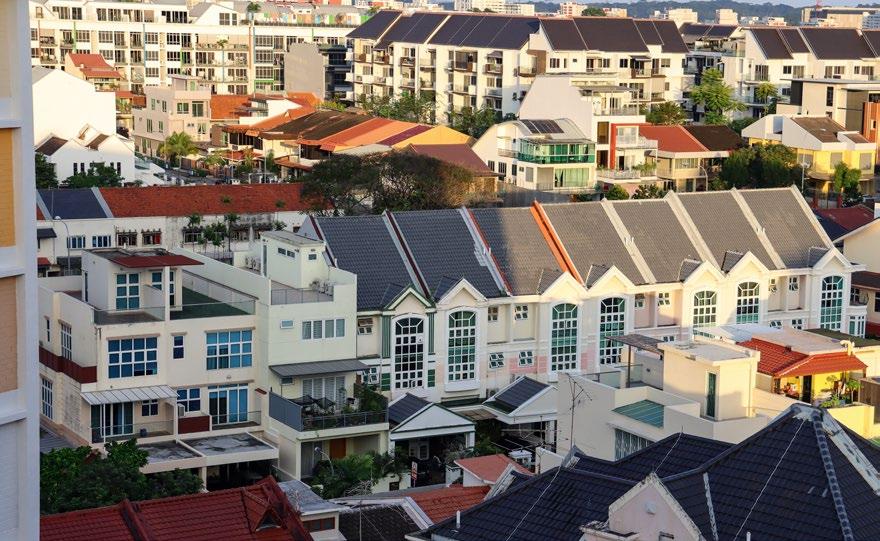
The strata commercial market is expected to see more activity in the coming months, lifted by various factors such as lower interest rates that have boosted investor returns.
“We see more strata-titled properties being put on the market as owners who have held these assets for some time look to extract profit, given the stable capital growth over the years,” Daphne Poh, capital markets director at Cushman & Wakefield Property Services (Singapore) Pte. Ltd., told Singapore Business Review
Older trading firms and private families are emerging as the main sellers of units in larger buildings, often in preparation for retirement or succession planning.
Huttons Asia Pte. Ltd. Chief Executive Officer Mark Yip noted that strata offices continue to draw “steady interest,” though supply remains limited. Amongst recent offerings are 108 Robinson Road, 137 Cecil Street, Ascent 456, Fortune Centre, One Sophia, The Golden Mile, and Visioncrest.
“Declining interest rates have resulted in positive carry for funds, and that is spurring demand in the strata office market,” he said in an interview.
Knight Frank LLP recorded 189 strata office transactions in the first half of the year worth $699.6m, including 15 deals above $10m.
Notable transactions included multiple units at 20 Collyer Quay ($91.8m), Tokio Marine Centre ($67.5m), as well as 108 Robinson Road ($55.8m).
Beyond offices, co-living is emerging as a growth area. Investors are shifting into the hospitality-led housing segment, with Jones Lang LaSalle, Inc. (JLL) reporting more than $1.4b in co-living deals since 2022.
Retail is also evolving. According to JLL Senior Director Zoe Ho, demand is moving away from traditional shopping formats towards mixeduse, lifestyle-driven spaces that blend retail with entertainment and community elements.
In the industrial sector, Cushman & Wakefield Director for Industrial Leasing Darren Lu sees stronger activity in data centres and high-specification assets, spurred by growth in technology, artificial intelligence, and life sciences. Ho added that life-science real estate would benefit from ageing populations and biotech advances.
These buildings let tenants tell their stories in ways conventional buildings cannot.
Heritage shophouses in Singapore are attracting renewed interest from luxury, wellness, and lifestyle brands, as developers restore conserved buildings to create distinctive retail and dining experiences that modern structures cannot replicate.
Real estate investment firm 8M Real Estate, whose portfolio is 90% shophouses, said these properties allow tenants to tell their brand stories in ways conventional buildings can’t.
“They are seeking very unique locations, especially those with heritage or with a rich culture or history behind them,” Xin Rui, executive director of asset management at 8M, told Singapore Business Review in an interview.
“For them, it is important because they want to connect with the local markets,” she continued.
Beyond food and beverage, operators in the wellness industry are moving into heritage units.
“One of the trends that has been growing in recent times is the wellness industry — for example, fitness and sports recovery,” according to Rui, noting that such tenants value community connection.
Other experiential concepts, such as pottery studios and DIY (do-ityourself) craft shops, are also driving demand for shophouses.
Mary Sai, executive director of capital markets at Knight Frank Singapore, described heritage shophouses as “trophy assets” whose prices have been climbing in the past 15 years due to factors like scarcity and the branding benefits of enclave gentrification.
High-net-worth people and family offices often accept lower yields in exchange for capital preservation and prestige ownership, she said.
Conservation rules keep supply tight, which supports long-term values, said Yap Hui Yee, executive director of investment sales and capital markets at Savills Singapore. Shophouses’ flexibility— accommodating uses from retail and

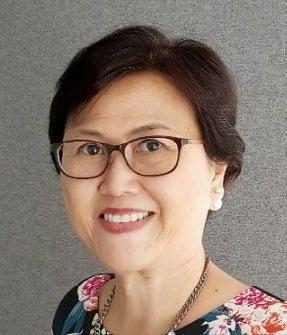


offices to hotels or serviced residences with approval—adds to their resilience.
Compared with other property types, they typically offer lower returns but higher potential for capital gains over time, Sai said.
“They carry higher illiquidity risk but are typically not affected by supply cycles that are characteristic of other asset types, such as offices.”
interest
Darren Sabom, managing director of investment management at 8M, said his firm is moving from acquiring single units to buying entire rows or blocks, such as a cluster of 15 shophouses in Tanjong Pagar, to create distinctive precincts.
Whilst these properties can be costly to adapt, the payoff is in the unique atmosphere they create.
“A high-end restaurant in a shophouse provides an authentic experience that you don’t get in a hotel or office building,” the managing director said.
Institutional investors including 8M Real Estate, Clifton Partners, as well as HSBC Asset Management have built significant shophouse portfolios, reflecting growing confidence in the asset class amongst major players.
Foreign interest has also increased alongside the expansion of family
offices in Singapore, which now number over 2,000.
Many buyers see shophouses as a hedge against currency depreciation and political uncertainty, especially since the COVID-19 pandemic.
Strict Urban Redevelopment Authority conservation requirements limit redevelopment and can make renovations costly, especially when preserving heritage facades with modern materials.
Even after upgrades for fire safety, accessibility, and mechanical systems, maintenance continues.
Yap cautioned that a property’s approved use can be a major risk. Converting ground-floor spaces to food and beverage outlets, for instance, requires official approval and may be rejected.
“To avoid costly surprises, it is advisable to engage an experienced shophouse broker who can verify permissible uses and guide investors through the regulatory process,” she told the magazine.
8M has tried to align each site with its neighbourhood’s cultural identity during tenant curation.
“We look at the location, the neighbourhood’s unique culture and identity, and also accessibility,” Rui said.


In search of the most notable real estate agents under 40, Singapore Business Review reached out to more than 35 property firms in the city-state.
After rigorously reviewing submissions from the firms, 10 women and 10 men made it to the final cut.
Agents on this year’s list come from Cushman & Wakefield, Huttons Group, JLL, MindLink Groups Pte Ltd, OrangeTee, and Savills. Leading the pack are Huttons Group and OrangeTee, with six representatives each. The youngest on the list is from JLL.
Realtors in the residential market took the lead, taking nine spots.
This year’s honourees are million and billion sellers and have handled big clients such as Maritime Port Authority, National Environment Agency, Ho Bee Land, CapitaLand, JTC, P&G, and LVMH.
Notable deals by this year’s honourees include the sale of an office floor at Solitaire on Cecil, which achieved the highest per square foot price ever recorded for a full floor in the Central Business District.
Here are this year’s honourees, arranged from youngest to oldest.

Chloe has been on JLL's Office Leasing Team for a year, after spending two years in Project and Development Services. She has quickly established herself as a valuable professional, building strong client relationships and contributing to the team's success. As both a tenant and landlord representative, she has gained a comprehensive understanding of the market. Chloe's notable transactions include closing 25 deals totalling around $780,000 with deals in key buildings like IOI Central Boulevard Towers and Millenia Tower.

Felicia has over seven years of real estate experience, specialising in tenant and landlord representation. She has successfully managed the full transaction cycle for numerous high-profile projects. Clocking 150,000 square feet in annual transactions, her track record includes major clients like Hewlett Packard Enterprise and Horiba. She has also secured exclusive mandates with CapitaLand and JTC, consistently driving higher occupancy rates. As a trusted adviser, Felicia provides market research and consultancy reports.

Esther specialises in Singapore's commercial office leasing market, bringing a 360-degree perspective from her work in both landlord and occupier representation. She has been the top-earning non-director-level broker for two years in a row. Her notable landlord representations include prominent buildings such as One George Street, Keppel South Central, and Hong Leong Building. On the occupier side, she has represented major corporations across diverse sectors, including AIG, ANT Financial, AET Tankers, and IPG. Esther delivers tailored real estate solutions by strategically understanding clients' business objectives.

Jian Hao is a direct and results-driven agent known for his straightforward approach to difficult listings. With a year of experience at his current firm, he believes every property is sellable. His recent transactions highlight this tenacity, including the sale of a mid-floor unit at Penrose that faced the PIE expressway, amounting to $2.03m, which he sold above the highest previously transacted price for that stack. He has also successfully moved other "difficult" units, including a property in Jurong West amounting to $775,000, earning a reputation for delivering results in the toughest deals.

Sophia has been in real estate since 2017 and, in just eight years, has risen to lead a dynamic team while consistently ranking as a top achiever. Known for her sharp market acumen and strategic thinking, she has achieved record prices in competitive segments, swiftly secured tenants for challenging commercial spaces, and guided clients toward cost-saving financing solutions. Notable deals include selling her first strata shop at 2 Fowlie Road within a month above expectation and assisting an overseas client to purchase Park Place Residence fully online. With nearly 200 transactions, Sophia continues to earn lasting client trust.
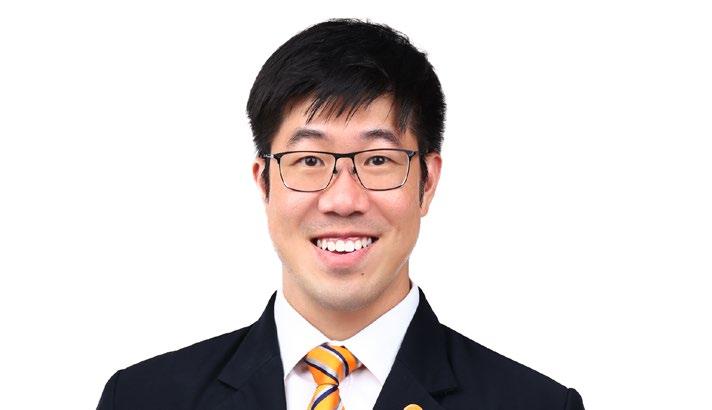
Zen is a results-driven real estate leader known for strategic thinking and a deep commitment to client success. With a strong track record in both residential and investment sales, he has achieved above-market prices for sellers and secured premium properties for buyers. Notable achievements include helping clients acquire two units at Jalan Terang Bulan Terrace for $5.7m, negotiated $300,000 below asking against competition, and securing a record-price rental at 28 Imperial Residences within a month through effective staging. With ethical practices, transparent communication, and sharp market analytics, Zen has earned a reputation as a trusted adviser in Singapore’s real estate market.

Qing Jie joined the industry in 2017, bringing his economics and finance background with a genuine passion for helping his clients. A consistent top achiever since 2020, he led as Project IC for the remarkable launch of Lentor Central Residence. His highlights in 2025 include achieving record price at Sims Urban Oasis within a month and realising close to $1m profit for a family that moved to Cabana from their Punggol HDB several years ago. Valued for his honesty and clientfirst approach, Qing Jie makes complex transactions seamless and rewarding. He has also consistently achieved premium sales prices for his clients, often well above market expectations.

Since entering real estate in 2020, Sam has quickly emerged as a high-performing leader with a proven track record in both residential and investment deals. Known for reliability and client trust, he now leads a dynamic team with fresh perspectives and a collaborative spirit. His portfolio showcases standout achievements, including securing a record-high $1.86m sale for a 3-bedroom unit at Sunny Spring Condo for Mdm Rosni and negotiating a rare 2-bedroom patio unit at Miltonia Residence below market value for Mr Lim. With sharp marketing strategies and market analysis, Sam consistently delivers optimal outcomes for first-time buyers, investors, and upgraders.

For Clarie, real estate is about people and relationships. Over the years, he has built a reputation for integrity and genuine commitment to clients. Clarie leads a team of 25 agents. Specialising in Singapore’s core central districts, he primarily serves highnet-worth clients, offering well-researched advice. A key milestone was the $4.8m sale of a home in Tribeca by the Waterfront, completed without any physical viewing. Another notable deal was the $6.08m sale of a unit in Volari, the highest transaction in the development. Clarie's success is rooted in his service-first approach and a focus on building long-term relationships.

Jon is consistently ranked amongst the top producers, with a strong track record in both residential resale and new launch markets. One of Jon’s most fulfilling transactions involved helping a young couple upgrade their home. Through detailed planning, timeline mapping, and financial analysis, he guided them to sell their existing unit within a day, securing a $1.56m unit at Sol Acres at one of the lowest PSFs, and building a financial safety net for eight years. He also guided a client with a $3.5m budget for a 3-bedroom resale condo to instead secure a brand new 5-bedroom at Parc Komo for about $3m.

Adora has built a decade-long career in real estate since joining the company in 2014. She quickly established herself as a trusted adviser and team leader, combining sharp business acumen with a results-driven approach. As Lead IC for the RiverGreen launch, she steered a high-performance campaign that exceeded sales projections. Her track record includes achieving a record-high $1.13m sale for a 4-room HDB at Skyville@Dawson and securing a $3.2m dream home at Nava Grove. Known for her patience and meticulous attention to detail, Adora delivers standout results while mentoring a growth-oriented team and inspiring client confidence.
12 Damien Tan 35, OrangeTee & Tie Pte Ltd

Within just three years in real estate, Damien has established himself as a dynamic young leader and consistent top achiever. He achieved over $100,000 in sales commission in a single month and leads the high-profile One Marina Garden project while also serving as Project IC for Elta. His portfolio spans both new launches and resale, including helping buyers secure a prime unit at One Shenton in District 1 below listed price and closing dream homes in launches such as The Opus. Known for persistence, patience, and sharp analysis, Damien consistently exceeds expectations while delivering exceptional client service.
15 Zoe Ho 36, JLL

With 14 years of experience in the commercial real estate sector, Zoe has built a reputation for excellence through her expertise in market dynamics and client relationship management. Zoe's portfolio includes numerous highprofile transactions, with notable tenant representations for multinational corporations such as P&G, LVMH, Moet Hennessy, and Ripple. She has also successfully represented prominent landlords, including 18 & 20 Cross Street, 60 Anson Road, and Shaw Tower. Her consultative approach and commitment to client service have been instrumental in driving significant value in Singapore's competitive office market.
13 Frederick Neo 35, Huttons Group

Since entering real estate in 2021, Frederick has emerged as a consistent Top Producer and Huttons Rising Millionaire. A former research engineer, he applies his analytical mindset and practical approach to guide clients in making confident property decisions. His business acumen and creative marketing have driven record-breaking results, including a $4m landed home sale at Springleaf estate despite its challenging traits. Beyond sales, his investment foresight has grown clients’ wealth, such as an HDB upgrader’s $3m Parc Clematis purchase that appreciated by $700,000 in under three years. Today, Frederick leads a dynamic team of 13, championing collaboration and growth.
16 Foo Shi-Yin Samantha 36, Savills

A veteran in the real estate industry with 13 years of experience, Samantha specialises in international real estate. With a background spanning various industry functions, she has honed her skills in sales, marketing, and negotiation. Samantha specialises in the Japanese property market, building a robust portfolio for Savills over the past two years. In the last year, she closed $36m in gross development value (GDV) across 19 transactions, including a complex $14m deal for a 48-unit hospitality block in Osaka. She continues to serve clients globally, offering her insights into markets like London, Sydney, Dubai, and Singapore.
14 Daphne Poh 35, Cushman & Wakefield Singapore

Daphne specialises in mid-market commercial properties valued between $10m and $100m. She focuses on shophouses, strata offices, and small buildings. Her 9 years of industry experience include a senior marketing role at a major real estate agency, which provided her with comprehensive exposure to conservation shophouses. Over the past three years, Daphne's notable transactions include the first brokered sale of Solitaire on Cecil for over $52m, the highest sales value to date at 15 Scotts exceeding $41m. and the highest single-transaction value at ARC380 surpassing $25m.
17 Yvonne Chua 37, Huttons Group

Yvonne is a Top Producer at Huttons, known for her exceptional service and client-first mindset. She is experienced across diverse market segments, including HDBs, condominiums, and commercials. One standout deal was a unit at The Lenox, left unsold for two years, which Yvonne sold in just a month for $1.2m. She also helped her clients to sell their $3.02m unit at The Anchorage and transition to a home better suited to their lifestyle. Yvonne leads a dynamic team of six with a “serve with a heart” approach, believing that strong relationships built on care and commitment lead to smooth, wellsupported property journeys.

Darren has over 13 years of experience in Singapore’s Industrial and Data Centre real estate, specialising in leasing and investment. He has advised occupiers including Hewlett Packard Enterprise, Maritime Port Authority, National Environment Agency, Home Team Science & Technology Agency, Horiba, and Razer on transactions and portfolio optimisation. On the landlord side, he has supported Ho Bee Land, CapitaLand, and JTC with leasing strategies. Before Cushman & Wakefield, Darren spent 8 years at Mapletree Industrial Trust focusing on acquisitions. He also runs a property video channel on TikTok with a strong following.

Shaun, District IC and core leader of Huttons Landed Division, drives one of Singapore’s top-performing landed teams. He mentors over 30 associates, fostering their growth while remaining personally hands-on with clients. Known for cinematic precision, Shaun curates listings with crafted content that maximise visibility and results. With a track record of closing more than one landed transaction almost every month, his recent highlights include a $6.65m Bright Hill Estate purchase and a $6.3m Serangoon Garden Estate sale. He applies his proprietary Landed Quotient framework and technical skills to align data precisely with client goals.

Val is a consistent Top Producer who entered the industry in 2017 and was awarded Top Rookie in her debut year. Alongside her husband Randy, she specialises in asset progression and digital outreach through Meta and PPC campaigns. In 2020, she helped clients sell a previously unsold listing at $480,000. Another memorable case saw her guide a client through every stage of his property journey, from renting rooms and HDB flats to purchasing a $3.98m unit at d’Leedon. With a Master’s in Psychology and experience as a psychotherapist, Val brings a deeper understanding of her clients’ needs and decision-making processes.

Ageing properties and lease expirations remain pressing concerns.

R2026, agents
16
eal estate practitioners in Singapore are calling for greater digitalisation across the industry, citing the need for a unified property data platform to address inefficiencies in the dealmaking process.
Jones Lang LaSalle, Inc. (JLL) Senior Director for Agency Leasing Zoe Ho said fragmented data remains a major obstacle.
“A key area for improvement is the standardisation of property data,” she told Singapore Business Review. “Critical information such as verified building specifications and sustainability metrics is often fragmented, creating inefficiencies in the due diligence process.”
“A more unified and trusted data source would allow for faster, more reliable comparisons,” Ho, who was recently named amongst Singapore Business Review’s most notable agents under 40, said in an interview.
"This would free up agents to focus on high-value strategic advice and empower clients to make quicker, more confident decisions, ultimately creating a more transparent and efficient market for everyone."
Agents must consult the Urban Redevelopment Authority, Singapore Land Authority, and Building and Construction Authority (BCA)



separately for building specifications. Sustainability data, meanwhile, comes through BCA’s Green Mark Scheme and other platforms.
Cushman & Wakefield Property Services (Singapore) Pte. Ltd. Director for Capital Markets Daphne Poh said greater transparency would cut delays and strengthen market trust.
“Streamlined processes and better market information would reduce delays, increase trust, and help buyers, sellers, and agents make faster, more informed decisions,” she said in an exclusive interview.
Huttons Asia Pte. Ltd. CEO Mark Yip urged stakeholders to work more closely in raising industry standards.
“The industry still lags behind in digitalisation, whether in sales or leasing,” he said. "Whilst individual agencies have developed their own tools ranging from analytics such as transaction data and trend charts to efficiency-focused solutions like digital forms and property searches, what is missing is a consolidated, industry-wide effort.”
Beyond fragmented data, ageing properties and lease expirations remain pressing concerns. Ho said these issues make transactions more complex as buyers and occupiers become more selective.
“Decisions around how much space to take, how to use it effectively with new ways of working, and how to plan for future growth amidst potential cost pressures require deeper strategic analysis,” she added.
Transaction timelines have also lengthened, now taking one-and-ahalf to two times longer.
Ho cited more detailed business analysis, stricter budget reviews, and landlords implementing tougher Know Your Customer requirements as key reasons.
As deals become more sophisticated, advanced data analytics could help agents manage complex transactions with greater speed and accuracy, she added.
Cushman & Wakefield Director for Industrial Leasing Darren Lu said brokers must sharpen their value proposition, whilst Yip encouraged agents to go beyond surface-level numbers with insights and analytics. Continuous learning is also vital, Yip said, citing a government decision to raise compulsory continuous professional development hours for registration renewal. Starting next year, agents must complete 16 hours annually, up from six, with 12 hours of structured training and four hours of self-directed learning.
Huttons also conducts courses for its agents, with new salespersons undergoing a mandatory “fasttrack” programme, Yip said. Ho said the proposed rule requiring agents to close at least one deal a year would keep them active and updated on market trends, ensuring they give sound advice. “This policy would raise the overall calibre of the industry by distinguishing active, committed professionals from inactive ones.”
However, Cushman & Wakefield Senior Manager for Industrial Leasing Felicia Tan said the rule might place undue pressure on agents in niche or long-cycle markets. “A more balanced evaluation framework that considers professional development, client engagement, and contributions to the firm may be a fairer measure of effectiveness,” she continued.



In search of the best architecture professionals under 40, Singapore Business Review reached out to more than 25 architecture firms in the city-state. After rigorously reviewing submissions from the firms, eight women and 12 men made it to the final cut.
Agents on this year’s list come from Aedas Architects, CPG Consultants, DP Architects, HYLA Architects, JGP Architecture (S), ONG&ONG, RSP Architects Planners & Engineers, SAA Architects, and Swan & Maclaren Architects. Leading the pack is DP Architects, with six representatives. The youngest on the list is from ONG&ONG.
This year’s honourees designed and managed major projects such as Woodlands North Station and JTC Bulim Square, as well as properties including Paya Lebar Green, The Golden Mile, Marina One, Hotel Faber Park, Minion Land in Universal Studios Singapore, and Hyll on Holland. One of the honourees is involved in the upcoming Changi Airport Terminal 5 project.
Here are this year’s honourees, arranged from youngest to oldest.


Wenwei advocates for a design approach that balances innovation, sustainability and cultural sensitivity. His expertise includes a mix of new-build and Additions & Alterations (A&A) work for hospitality, retail, and institutional projects in Singapore and abroad. In Singapore, he played a key role in the completion of two major hospitality landmarks: the Pullman Singapore Hill Street and Pullman Singapore Orchard. His international portfolio includes retail planning for Empire City in Vietnam and the A&A for Grand Indonesia Mall in Indonesia.


Ryan has a diverse portfolio across public and private sectors. His work focuses on creating practical, sustainable, and community-friendly designs for institutional, commercial, and educational facilities. His most meaningful completed project is the Pathlight School (Tampines), a campus for special needs children that combines accessibility with inclusivity and features a publicly accessible landscaped forecourt. Ryan's first completed project was the Jurong Town Hall Bus Interchange, which he designed with a focus on accessibility, efficiency, and user comfort.

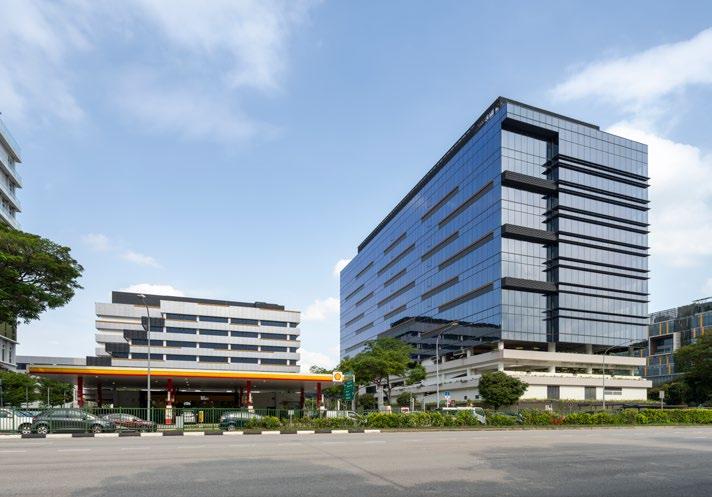
Timothy uses technology to enhance his projects' creativity and productivity. With his expertise in BIM and understanding of Singapore's complex regulatory frameworks, he offers design solutions at every stage and scale of any project. Having worked with distinguished clients, including Lendlease, Certis, Great Eastern and the Singapore Grand Prix, his key projects include Paya Lebar Green, and his work on the F1 Singapore Grand Prix 2023 for Paddock Club Atrium (PCA) and the F1 Singapore Grand Prix 2024/2025 for A&A works to the PCA.


Yih Xi has a Master in Architecture (specialisation in Urban Design) from the National University of Singapore. With six years of experience, her portfolio spans both public and private sectors. As Project Architect for St. Andrew’s Community Hospital (Bedok), she led design coordination and on-site implementation. She also joined The Landmark, which is high-rise condominium, during its completion stage and is currently developing an immersive cinema experience for Shaw Theatres at JEM.


Fadzli is a people focused professional who turns bold ideas into meaningful realities through collaboration and clear communication. With a hands-on approach from design to execution, he blends ambition with technical precision to deliver standout projects. His portfolio features Mandai's Indoor Attraction Buildings, Exploria and Curiosity Cove, and the upcoming Changi Airport Terminal 5. A Green Mark Accredited Professional, Fadzli drives sustainability and industry innovation whilst holding leadership positions in community organisations.


A registered architect with eight years of experience, Stephanie has demonstrated exceptional leadership and dedication across various project types. She has worked as a Design Architect and Project Architect, excelling in both roles. She is currently involved in the infrastructure projects within the Bulim precinct. Her portfolio includes the Woodlands North Station – part of the Rapid Transit Link – and JTC Bulim Square, a 1.7 million sq ft industrial mixeduse development. She also contributed to Northpoint City and managed the A&A works for Choa Chu Kang Sports Centre.


Anissa is a Registered Architect and Green Mark Accredited Professional with over eight years of experience. Her portfolio spans typologies including the Jurong Lake District Masterplan, JTC Bulim Square, and Tanjong Katong Nursing Home. She has led projects from concept to completion, such as the Asset Enhancement Initiative for 108 Robinson Road, Urban Treasures, and is currently Project Architect for The LakeGarden Residences – one of the first private condominiums to achieve Green Mark Platinum SLE. She also contributes to SAA’s design stewardship.


David believes that learning different design languages and cultures unlocks diverse perspectives, which the registered architect integrates into his work. Embracing complexity, he views architectural solutions as shaped by contextual factors rather than a linear process. His completed projects include The Verandah Residences, Affinity at Serangoon, Midwood, Mayfair Modern, Mayfair Gardens and Boulevard 88. He also worked on the A&A works for Duo Andaz and The Singapore Edition Hotel, and was involved in Aurea, the residential component of the ongoing rejuvenation of The Golden Mile.

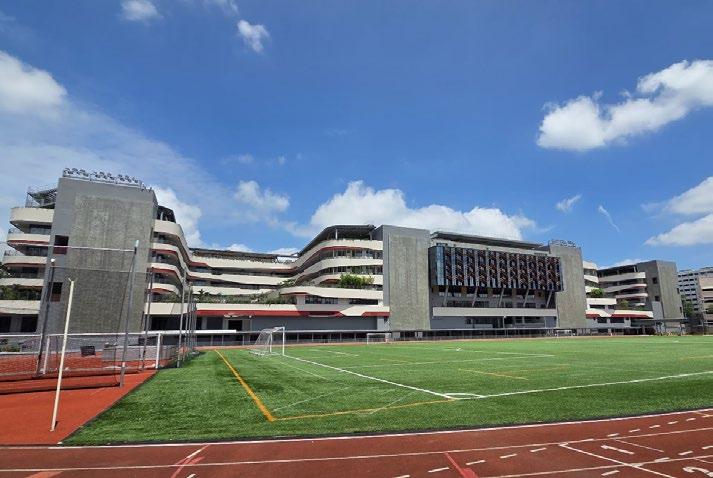
A graduate of the National University of Singapore with a Master of Architecture degree, Qiao Yan is a registered Architect with eight years of experience. As a Senior Principal Architect at CPG Consultants, her diverse portfolio spans educational, residential, and commercial projects, with a growing focus on educational institutions. She is currently shaping the future of learning spaces through her involvement in the Singapore American School Campus Upgrading Project and the Anderson Serangoon Junior College redevelopment, creating environments that will nurture future generations.


Wanxuan’s work is defined by her strong commitment to adaptive reuse and community-focused design. She was instrumental in the design and project management of the ongoing rejuvenation of The Golden Mile, where she helped shape a network of internal urban streets that connect to a vibrant streetscape, thus breathing new life into the conserved building. Beyond design, she oversees site management to ensure proper protection of conserved elements during construction. At Plantation Village, a public housing project, she helped create interesting communal spaces.


With a strong background in large-scale master planning, Yili is adept at managing complex projects from conceptualisation to completion, focusing on hotel, mixed-use and commercial typologies. Her extensive skills, honed through feasibility studies and rigorous design competitions, enable her to lead and coordinate multi-disciplinary teams effectively. Her key projects include Hotel Faber Park and Lusail Commercial Boulevard, with the latter showcasing her expertise in master planning and project coordination. Yili is also actively involved in the firm's code arm to ensure a high-quality standard of work delivered.

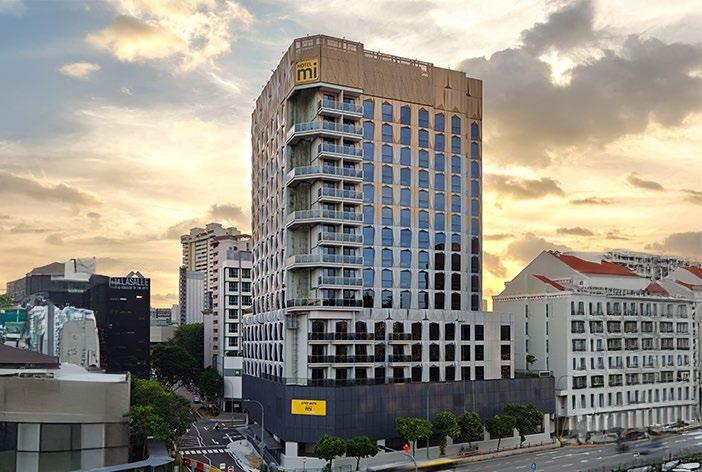
Ethan combines analytical precision with a human-centric approach. He has six years of experience across various sectors. His completed projects include Hotel Mi Rochor, St. Regis Residences, and the Remodelling of Wards 10 and 11 at Alexandra Hospital. He also contributed to the transport infrastructure design for Loyang MRT Station and workplace interiors for Capital Tower's Caphub 2.0. Beyond his professional work, he led the rebuilding of Ah Ma Drink Stall on Pulau Ubin and was a volunteer lead for a planned heritage museum in Queenstown.

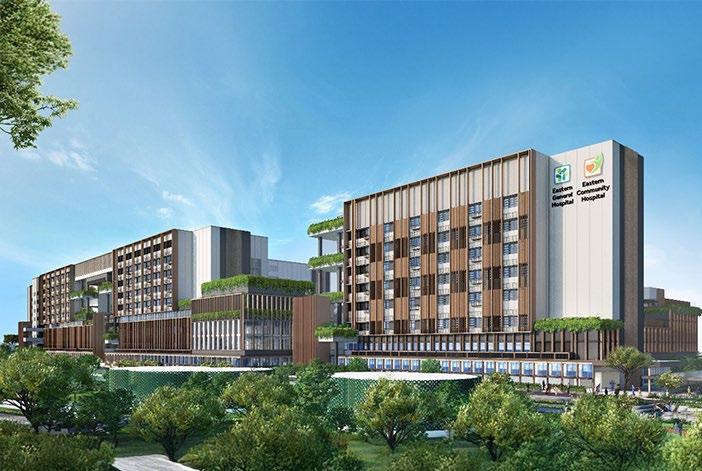
Yoga is a Senior Principal Architect at CPG Consultants, with experience in large-scale public sector projects, including healthcare and mixed-use developments. Guided by a human-centric approach, he creates architectural solutions that balance functionality, inclusivity, and community well-being. A certified Universal Design Assessor, Yoga is also a part of the Built Environment Young Leaders programme. He is currently working on the Eastern General Hospital (EGH) Campus project. Looking ahead, he aims to continue championing inclusive and sustainable architecture.


Fei is an architect with over a decade of experience and holds degrees in architecture and urban design. Her most notable completed project is Universal Studios Singapore expansion - Minion Land, where she played a key role from design development to execution. Fei has also contributed to a range of other projects, including Shaw Plaza and Tampines East Community Club, across various retail, recreational, and residential typologies. Her versatile skills and broad experience enable her to deliver functional, culturally sensitive designs that are meaningful to the communities they serve.


As Director of HYLA Architects, Nicholas Gomes continues the firm’s 30-year body of work in landed housing, defined by inventive form and material. Over the past decade, he has built a portfolio of more than 20 high-end houses, including Cloister House and Heaven & Earth House—each offering a distinct response to tropical living. A top graduate of the University of Tasmania and Gold Medal recipient from the National University of Singapore, his work is regularly featured in print and digital media, contributing to Singapore’s architectural landscape.

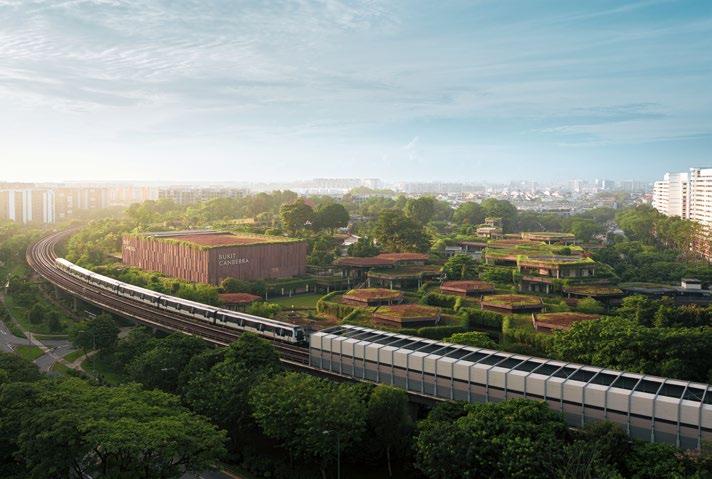
Frederick’s work spans multiple scales and typologies, from master planning to integrated hubs and small-scale developments. Key projects include Bukit Canberra, the NUS Land Optimisation Master Plan, and a Good Class Bungalow in Central Singapore. Frederick also holds a master’s degree in Sustainability Management from Columbia University, which complements his practice by deepening his understanding of how climate policy and environmental science shape strategies for the built environment. He is currently working on the restoration of a national monument whilst actively advancing DP’s sustainability efforts.


Rovi has nearly a decade of experience across various building types, including healthcare, institutional, and mixed-use projects in Singapore and Vietnam. His expertise spans design, documentation, and contract administration. His completed projects include the design and delivery of the International French School Singapore expansion, as well as leading various highend asset enhancement developments to the Marina Bay Sands Integrated Resort. He is also a design team member for regional projects such as Celesta Heights (Residential) in Vietnam.


Hyo Sun is a Singapore-registered architect with over 13 years of experience. In her role at SAA Architects, she is the regulatory lead for the Changi Airport Terminal 5AB project, a key strategic infrastructure development. Throughout her career, she has contributed to high-impact projects that have shaped Singapore’s landscape. Her completed projects include Marina One, a landmark mixed-use development, the National University of Singapore’s E7 Engineering & Medicine research facility, and the Singtel Waterfront Theatre, a vibrant arts and culture centre.


Wencan has a 12-year experience in architecture and holds a Master of Architecture degree from the University of Michigan. His strengths lie in bridging client vision with pragmatic execution and a human-centric approach that prioritizes the user's experience. He has worked on various project types across Singapore, China, and other countries. His completed projects include Hyll on Holland, the Asset Enhancement Initiative for Aperia Mall, One World International School in Punggol, and 1 & 7 North Coast, part of the Woodlands North Coast Master Plan.


Tony is a Senior Associate & Deputy Studio Master at JGP, with over 13 years of experience in Singapore & Hong Kong. He is an integral member of the JGP Healthcare Team. He has been actively involved in healthcare projects, including MOH Nursing Homes in Aljunied Road, Punggol Field, Tampines Street 96, Jelapang Road & Dover Road, as well as residential projects & design competitions. His diverse background includes past works on large-scale projects, including Temasek Polytechnic Campus Development & SIT, MRT Circle Line Stage 6 & Kansai International Airport A&A.


Clients want buildings that are integrated and human-centric.
Property owners are abandoning single-purpose projects in favor of buildings that function well and enhance how people experience them.
“There is increasing demand for mixed-use developments, integrated transit-oriented projects, and community-centric spaces that respond to evolving urban lifestyles,” David Chim, executive director at Aedas Architects, told Singapore Business Review in an exclusive interview.
'Human-centric' designs
Clients are seeking buildings that are “integrated” and “human-centric,” said Ng Meng Hui, managing director at RSP Architects Planners & Engineers. Projects are expected to be porous, biophilic, and closely linked to their surroundings. “There is a strong trend towards dissolving walls between a building and its surroundings, blurring boundaries for greater community engagement,” he said.
RSP’s SIT Punggol Campus Court shows the shift. The campus connects directly with the Park Connector Network along the Punggol Promenade Nature Walk, letting joggers and cyclists pass through its grounds and use facilities such as the food court.
At ONG&ONG Pte. Ltd., architect Ryan Teo said sensory inclusivity is being incorporated into design. For Pathlight School (Tampines), his team created alcoves with tactile wall installations to offer students calming spaces. “These small touches make a big difference in making spaces feel warm, safe, and welcoming,” he said.
Accessibility has become central to human-centric design. RSP’s Bird Paradise was designed with wide, gentle walkways and cooling rest stops to ensure ease of use for wheelchair users, families with prams, and visitors of all abilities.
Singapore’s revised Code on Accessibility in the Built

Environment, effective from 1 November, now mandates features such as grab bars, rest areas, and standardised tactile indicators.
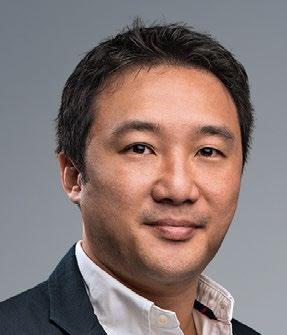

SAA Architects Pte. Ltd. Director Ivy Koh said the revised code would be a “core design driver,” influencing planning from the earliest stages.
The firm’s mixed-use GENEO at 1A Science Park Drive uses barrierfree access, tactile wayfinding, and inclusive amenities for people with disabilities.
Flexibility and adaptability are also shaping demand. Ng said stakeholders want properties with flex spaces — areas that can shift functions with sliding walls or technology. Teo added that rigid layouts are giving way to designs that support work, rest, and socialising in the same footprint.
Koh noted that health campuses
are increasingly designed to expand bed capacity when required, whilst in the residential sector, landed properties are being redeveloped into multigenerational homes.
Elizabeth Hardie, an architect at ONG&ONG, said developers are planning for future upgrades.
“This has led to increased demand for additional mechanical and electrical shafts and design provisions that allow for future upgrades, such as the easy installation of new piping or wiring without disrupting existing building functions,” she said in a separate interview.
Sustainability is another driver.
Chim said more asset enhancement and adaptive reuse projects are being commissioned as clients seek to reduce carbon impact whilst meeting user expectations.

Minimum coverage starts at $1m, rising with the size of the firm up to $50m.
Small and medium enterprises
(SME) in Singapore may become more willing to hire sole proprietors and partnership-run accounting firms once proposed rules making professional indemnity insurance mandatory take effect, according to analysts.
“This reform is a positive step towards increasing SMEs’ trust in hiring freelance or small-firm accountants,” Karen Yeo, head of financial lines at Howden Singapore Pte. Ltd., told Singapore Business Review. “Given that accounting firms are regulated by the same professional standards, SMEs would have greater confidence in engaging smaller firms," she continued.
The Accounting and Corporate Regulatory Authority (ACRA) said 408 accounting firms operating as sole proprietorships or partnerships would be affected. At present, only accounting corporations and limited liability partnerships (LLP) must have professional indemnity coverage, which protects firms against claims


from negligence or errors.
A public consultation on the proposed changes closed on 31 July, but no implementation date has been announced. Once effective, firms will have six months to comply. Minimum coverage starts at $1m, rising with the size and revenue of the company up to $50m.
“ACRA will conduct compliance checks to ascertain whether the accounting entities comply with the professional indemnity insurance requirements,” the agency said in a statement. “If noncompliance is found, disciplinary action may be taken against the public accountant and/or the accounting entity.”
Industry bodies say the requirement could benefit both clients and practitioners.
Terence Lam, director of advocacy and professional standards at the Institute of Singapore Chartered Accountants (ISCA), said sole proprietorships and partnerships face unique risks since they are subject to unlimited personal liability.

“Unlike public accounting corporations and LLPs, they are subject to unlimited personal liability, meaning their personal assets could be at risk in the event of a claim,” he said in a separate interview.
“Requiring professional indemnity insurance helps ensure that clients are not left without recourse, and practitioners are not left personally vulnerable," he continued.
Lam told the magazine that the process of securing the insurance encourages firms to better understand exposures such as data protection and cybersecurity.
Costly legal expenses
Yeo noted that insurance policies cover not only damages awarded by the courts but also defence costs, which can be substantial.
She cited the case of a Howden client who acted as liquidators and faced a third-party claim exceeding $500,000 for alleged misuse of rental income and breaches of duty. Howden arranged the professional indemnity policy that provided for the legal defence and continued support when the case was reopened, before the firm eventually succeeded in having the claim dismissed.
In another case, Yeo said a small firm faced a $600,000 lawsuit from two investors over alleged mismanagement. The dispute was eventually settled, with the policy covering over $500,000.
“Legal expenses can be costly in Singapore, and having professional indemnity insurance is a costeffective way to transfer such risks to the insurance market whilst protecting the individuals’ personal assets,” she said. “SMEs would have greater assurance that in the event of claims, there would be a right of recourse," she continued.
Yeo warned that a major claim could otherwise sink a small practice, leaving clients struggling and unable to recover losses.





We are compelled to meet the global demand for safe animal protein. As the world’s population continues to grow and the demand for protein soars, Kemin is dedicated to developing ingredients that help producers raise healthy livestock. We are a trusted market leader in the animal feed, beef, dairy, poultry, swine, and equine industries.
Our wide variety of science-backed solutions help optimise nutrition, improve gut health, support immune function, improve the absorption of nutrients, extend the shelf life of feed, and reduce harmful pathogens in the feed and water animals consume. Energised by our curiosity, we never stop pursuing more effective ways to protect our food supply at the source.
They offer stability and in-depth estate planning solutions.
Wealthy families are turning to flexible life insurance plans that also earn interest to manage wealth transfer, as fewer children opt to take over the family business.
“In terms of wealth transfer, that’s another big issue that some of our clients are facing,” Katherine Ho, managing director at Lioner International Group Ltd., told Singapore Business Review, noting that many of their clients have family members who live overseas and have chosen different career paths.
As a result, estate planning is shifting away from handing down businesses to managing inheritance and family finances, she said.
More families are looking for tools with more flexibility and stability, such as indexed universal life (IUL) policies, which are linked to stock market performance but protect against losses, she added.
“They offer a pretty good alternative in terms of their portfolio, because you’re looking at long-term asset allocation,” Ho said. “They provide capital stability and give clients exposure to in-depth planning solutions," she added.
With indexed life plans, your money can grow when markets do well, but you won’t lose anything if the market drops, she pointed out. Settling an estate can also take a long time—sometimes up to two years, in contrast to indexed universal life plans, where beneficiaries can access funds more quickly.
Leonard Chu, CEO at Lioner, said newer insurance products are better suited for families spread across different countries.
“We now see expanded insurance solutions that provide liquidity during estate settlements, cover beneficiaries across different jurisdictions, and at the same time incorporate tax optimisation, asset preservation, and privacy protection,” he said in the same interview.
Louise Thean, chief proposition officer at Grandtag Financial




Consultancy, said universal life policies are used as a smart wealth planning tool—not just for life insurance, but also to preserve assets, handle tax issues, and plan legacies.
According to Rena Lim, head of high net worth and financial advisory at Manulife Singapore, rising life expectancy means people must plan for longer retirements.
“Indexed universal life plans are uniquely suited to address this challenge, providing market-linked growth to sustain wealth over decades whilst offering downside protection,” she said.
In April, Manulife launched an indexed life plan that is linked to five global stock indices, including the S&P 500 and Hang Seng Index, and has a built-in safety net that protects clients from losses.
It also spreads investment over a year to reduce timing risks.
Global demand is also growing.
A 2025 report by Capgemini showed that high-net-worth people in Asia saw a 4.8% rise in wealth last year, with Singapore emerging as a top hub. Hong Kong is also gaining
ground after easing the rules for indexed life policies.
“We see insurance carriers from Singapore going to Hong Kong, and Hong Kong insurers coming to Singapore, trying to understand each other,” Thean told Singapore Business Review. “Hong Kong’s liberalisation of IUL rules is likely to divert some flows, especially amongst Greater China high net-worth individuals.”
Still, analysts think both could grow together. “Both jurisdictions can work together and complement one another to serve these high-networth families because there’s simply a lot of demand for diversification of risk—and in that regard, diversification of assets between different jurisdictions,” Chu said.
The market is also evolving with technology and customisation.
“Some insurers are already rewarding clients who quit smoking,” Ho said. “If someone’s health improves, maybe underwriters might consider giving them a slightly reduced premium."


The 17.26-hectare facility, featuring 3 docks and 1,250m of berths, is designed for operational scale and versatility—capable of supporting a wide range of vessels, including offshore, specialised, and Suezmax-class ships.
iHub5 is a new initiative designed to serve as the nexus for fostering collaborative partnerships to drive deep-tech solutions. iHub5 connects ecosystem stakeholders to leverage domain expertise, engineering capabilities, and operational insights to accelerate business growth and decarbonization.
Located within iHub5, the Centre of Excellence in Engineering R&D advances Kuok Maritime Group’s (KMG) technology interests such as digital twins, carbon capture, electrification, and alternative fuel solutions.

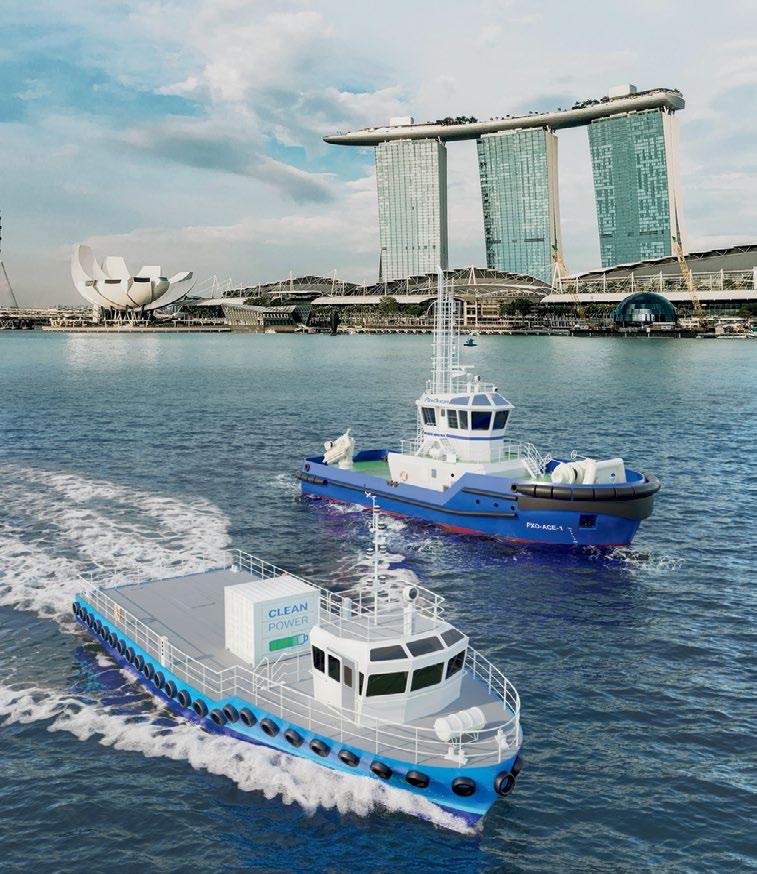

More people are using e-payment solutions such as PayNow and FAST.
Singapore’s banks are reporting a steep decline in cheque use as the country moves toward ending physical cheque payments by 2027, with businesses and consumers shifting to digital alternatives.
Cheque transactions have fallen steadily in recent years, a trend that Maybank Singapore attributed to fees imposed on cheque usage and the growing reliance on real-time payment systems.
“This decline has been driven by both the introduction of fees for cheque usage, as well as the growing adoption of convenient e-payment solutions such as PayNow and FAST, which many of our customers now rely on for day-to-day transactions,” Helena Ooi, head of strategy at Maybank Singapore, said in an exclusive interview.
At United Overseas Bank Ltd., the number of both corporate and retail cheques processed dropped 30% from a year earlier.
“Payrolls and accounting were amongst the top three digitalised processes for business this year,” Kwan Chee Sun, managing director of group wholesale banking and global market technology and operations at UOB, told Singapore Business Review.
UOB’s Business Outlook Study 2025 found that about eight in 10 companies have adopted digital tools, whilst consumer surveys show increased use of mobile banking and QR payments. More than 75% of digital payment users relied on these options at least once a week.
For wholesale clients, transaction volumes through PayNow, FAST and GIRO rose 10% in the first half from a year earlier. Retail customer usage of digital payments climbed 25%.
The decline in cheque volumes comes as the government enforces a phased withdrawal. Banks must stop issuing corporate cheque books and halt bulk cheque and self-printing services by January 2026.


All Singapore dollar corporate cheque processing will end a year later.
To fill the gap, the Association of Banks in Singapore (ABS) introduced two electronic deferred payment systems in July.
The platforms—Electronic Deferred Payment (EDP) and EDP+—are designed to replace post-dated cheques used for supplier and rental payments.
Under EDP, funds are deducted from the payer’s account only when the payee requests settlement, whilst EDP+ locks the funds immediately, ensuring they can’t be used for other transactions. The tools were developed in consultation with the Monetary Authority of Singapore along with local banks.
“With the planned discontinuation of cheques, there is a need for digital solutions that offer similar functionality,” ABS said in a statement. “Electronic Deferred Payment solutions were developed specifically to address this gap,” it added, noting that real-time
notifications give users visibility that cheques could not provide.
UOB noted that there has been strong initial demand for the products from both retail and corporate customers.
Kwan said the systems could be used for a range of payments, including supplier transactions, deposits for project tenders, and property-related payments such as rental or ballot deposits.
Maybank reported “moderate but steady” adoption so far. Ooi said the solutions are useful for small firms that no longer need to print, deposit or manually track cheques.
For property transactions, the head of strategy said EDP+ provides the security of a cashier’s order without requiring a branch visit.
The banks are also working to guide long-time cheque users through the shift. Maybank has issued stepby-step guides, digital outreach, and support from relationship managers to help businesses adjust.
“Early adopters have shared that they value the time saved by not having to print or deposit cheques, and the convenience of managing payments entirely online with realtime updates,” Ooi said.




Singapore and India’s green and digital shipping corridor is poised to unlock new opportunities for clean-fuel bunkering and infrastructure as the maritime sector boosts its efforts to align with the International Maritime Organization’s (IMO) target of netzero emissions by 2050.
Shahrin Osman, business development director for maritime advisory at Norway-based classification society DNV, said India’s renewable energy capacity of 234 gigawatts, based on Rystad Energy’s July report, positions it to produce zero- or near-zero-emission fuels.
“They have that ability to produce zero or near-zero fuels… that gives an opportunity to this ecosystem to look at how they could use this green and digital shipping corridor to enter into this alternative fuel bunkering,” he told Singapore Business Review. Singapore and India signed a deal in early September to establish the
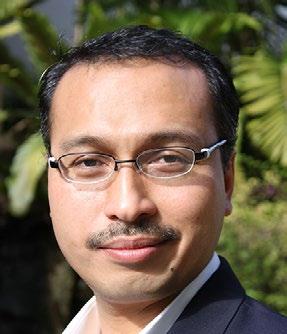

Singapore-India Green and Digital Shipping Corridor. The partnership seeks to develop infrastructure and technologies that support lowemission fuels and enable digital information exchange between ports.
According to Osman, alternative fuel bunkering could spur industries around fuel storage and supplier services.
“When you have the ability to provide that, then the port will become more attractive,” he said in an exclusive interview. “Even though they may not have cargo, load or discharge, if there is a competitive supply of cleaner fuels, then the vessel will call the port to get that supply.”
The partnership comes ahead of the IMO’s adoption of its Net-Zero Framework, which introduces penalties for ships that fail to meet emission targets. From 2028 to 2030, fees will be set at $129 (US$100) per tonne of carbon dioxide equivalent for ships near

compliance and $491 (US$380) per tonne for those further off-target.
Osman said such rules would push ship owners to adopt alternative fuels rather than pay penalties.
Beyond fuels, the corridor also opens the door for shore power supply at ports, where ships plug directly into clean electricity. Osman told the magazine that this could be four times more efficient and cheaper than producing synthetic e-fuels.
Goh Puay Guan, associate professor at the Department of Analytics and Operations at the National University of Singapore, said the digital side of the agreement could improve port operations.
“Digitalisation is an opportunity for improving efficiencies and cost effectiveness, which could be served by companies in supply chain visibility, artificial intelligence, data analytics, robotics and automation, that are able to customise these tools for the maritime industry,” he said.
Osman said ship owners could also integrate energy-saving technologies such as wind-assisted propulsion systems (WAPS). These can reduce fuel use and emissions by as much as 40%, though they require at least $646,049 (US$500,000) in upfront costs per vessel, DNV said in a report published in March.
About 50 commercial ships were equipped with WAPS as of January, with more orders expected.
Solar panels are another option, though their contribution is typically limited to a 2% reduction in fuel consumption due to space constraints on vessels, according to the report.
Osman cited Norway’s Green Shipping Programme as a model, with 19 of 53 pilot projects producing low- or zero-emission solutions since 2015.
Goh added that the SingaporeIndia corridor could expand to include other countries and broaden its coverage in the future.






Social media and e-commerce are raising shopper expectations.
Department stores are shrinking in size but widening their mix to include dining, wellness, and experiential retail as online shopping accelerates and foot traffic falls.
“Department stores like Robinsons, BHG, Isetan and Metro have downsized,” Sulian TanWijaya, executive director of retail and lifestyle at Savills Singapore Pte Ltd., told Singapore Business Review “There is a gradual shift from the traditional multi-brand department store format to more curated lifestyle concepts to keep up with changes in customer preferences.”
At Tang Plaza, the basement of TANGS has been converted into a Hawkers’ Street featuring heritage food, including Michelinrecognised stalls.
Specialty anchors such as Don Quijote Co. Ltd. now blend shopping with dining, whilst NTUC’s FairPrice Finest at


Clarke Quay has reimagined its supermarket into a Grocer Food Hall, where shoppers can choose fresh meat or seafood and have it cooked on-site for dining.
Fashion is also leaning into lifestyle. The Editor’s Market at Takashimaya incorporates café concepts inspired by Korean coffee culture, drawing in younger shoppers and customers.
Persistent pressure
Tan-Wijaya told the magazine that the changes reflect persistent pressures on the sector. High operating costs, rising rents, and competition from e-commerce are pushing traditional players to adapt.
“Inventory-heavy models are far less agile compared with fast fashion or D2C (direct-to-consumer) brands, and intense competition from e-commerce, social commerce, and specialty retailers is eroding their role as one-stop
destinations,” she said.
Ashutosh Awasthi, director of Kadence International, said the sector’s real challenge is innovation. “The real challenge is not about increasing cost. These are implications or outputs of the pace of innovation,” he said.
Online platforms, he said, are deploying artificial intelligence (AI)driven recommendations, virtual tryons, and personalised experiences, whilst physical stores lag behind. Consumers now expect interactive, immersive services.
“Shoppers now expect personalised services, whether it’s a style consultation or a live demonstration, but the experience must be more interactive, immersive and convenient,” Awasthi said in a separate interview.
He added that social media and the ease of e-commerce are raising shopper expectations.
In response to the evolving consumer trend, department stores are now experimenting with other concepts such as pop-ups, workshops, artisanal brands, interactive displays, and smart fitting rooms.
“I’ve come across a few stores in Singapore where they offer interactive displays throughout the store—you could just scan the product and it’ll give you further information through your smartphones,” Awasthi said.
Regional peers provide inspiration. Japan’s Isetan Mitsukoshi Holdings Ltd. have integrated luxury food halls and cultural events, whilst Korea’s Hyundai Department Store Co. Ltd. and Lotte Corp. feature art galleries and rooftop gardens.
“Both markets are also proactive with exclusive brand collaborations and creating experiential zones,” according to Tan-Wijaya.
She said Singapore retailers should follow suit with rotating brand showcases, exhibitions, celebrity appearances, and sustainabilityfocused sections that feature preloved designer apparel.
Retailers could also explore innovations such as shop-in-shop formats, communal shopping spaces, and sections dedicated to pre-loved designer apparel and accessories, Tan-Wijaya concluded.






It kept 91% of its customers in the past fiscal year—above the industry average.
Info-Tech Systems Ltd. is accelerating its overseas growth plans following its listing on the Singapore Exchange (SGX), according to its CEO.
“This strong Singapore branding holds much weight when we pursue our overseas expansion plans because Singapore is known for high standards for corporate governance and integrity,” CEO Babu Dilip told Singapore Business Review. “Being a Singapore-listed company comes with a certain level of trust," the chief executive said in an exclusive interview.
Info-Tech, which provides cloud-based human resource management (HRM) and accounting software, is focusing on expanding its market share in its existing markets: Singapore, Malaysia, Hong Kong, and India.
The small and medium enterprise (SME)-focused cloudbased HR and accounting software sectors across the four markets where it operates are expected to grow by as much as 11.9% annually from 2025 to 2029, “which bodes well for the group,” Dilip told the magazine.
“Info-Tech Systems is well-positioned to capitalise on the push for digitalisation that has driven the increasing adoption of cloud-based solutions particularly amongst SMEs,” the chief executive officer continued.
“Supported by pro-digital government policies, companies across various industries are moving towards Software as a service (SaaS) offerings such as ours as a key part of their digital transformation efforts,” he added.
Development plans
To support this growth, the company is developing artificial intelligence (AI)-powered features, including a chat tool that uses customers’ own human resources data to provide instant responses. Info-Tech is also working on a customer relationship management platform.
“Info-Tech Systems has a strong record in all these areas,” the CEO said. “Our system is plug-and-play, very easy to use. Once installed, the customer can use it straightaway with some brief training," he added.
To improve service, each client is assigned two dedicated support staff to ensure continuity, even during staff absences. “We also have an industry-leading four-hour response time."
Singapore clients could also benefit from a government grant that covers as much as 90% of eligible costs. The programme supports small and medium enterprises adopting approved digital tools to boost productivity.
Info-Tech kept 91% of its customers in the past fiscal year, which Dilip said is above the industry average of 70% to 85%.
The company raised $61.7m at its initial public offering on 4 July, with shares 7.3 times oversubscribed at $0.87 each.
Dilip said the Singapore Exchange listing sets the company up for long-term growth and leadership in HRMS and accounting solutions.
Being a Singapore-listed company comes with a certain level of trust
“We strongly believe that a public listing will help us to boost brand credibility, which will in turn further differentiate us among other SME-focused peers, attract top-tier clients, attract and retain top-tier talent, and strengthen corporate governance,” Dilip said.
“Additionally, listing will enhance our financial flexibility, allowing us to invest in research and development, expand our product offerings and scale globally without relying only on debt,” Dilip added.
The proceeds from the IPO will fund marketing efforts, research and development, regional expansion, and potential strategic acquisitions, according to Dilip.
Dilip said the Singapore Exchange listing sets the company up for long-term growth and leadership in HRMS and accounting solutions.
“We strongly believe that a public listing will help us to boost brand credibility, which will in turn further differentiate us among other SME-focused peers, attract top-tier clients, attract and retain top-tier talent, and strengthen corporate governance,” Dilip said.
“ Additionally, listing will enhance our financial flexibility, allowing us to invest in research and development, expand our product offerings and scale globally without relying only on debt,” Dilip added.
The proceeds from the initial public offering will fund marketing efforts, research and development, regional expansion, and potential strategic acquisitions.
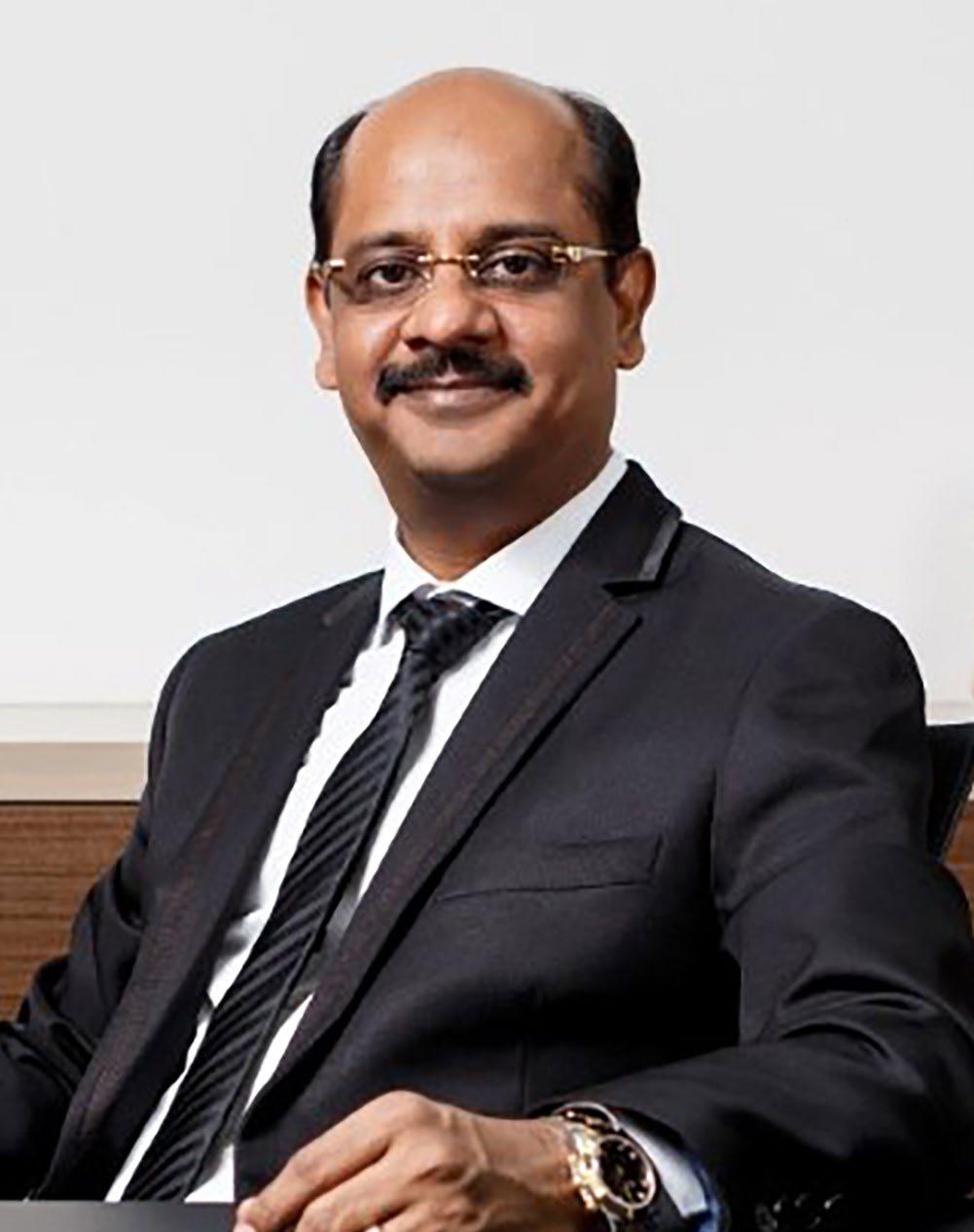





The app aims to unify banking, renovation, and property management services.
Realion Group is investing heavily in software and digital platforms to unify property technology services in the Asia-Pacific region.
“This is in response to the challenge of the abundance of applications and technologies in real estate that lack a singular, comprehensive, and client-focused approach in Asia-Pacific,” CEO Desmond Sim told Singapore Business Review. Their proprietary property technology platforms—such as the Agent App and advanced analytics tools—provide agents with real-time market data and insights, enabling data-driven decisions that enhance client engagement and improve overall consumer experience.
According to India-based research firm Introspective Market Research, the technology addresses how property transactions are carried out and also presents the possibilities for organising and improving the overall process for the purchase of all kinds of real estate assets.
The primary growth driver for the market is the rising demand for digitalisation in real estate operations.
Integrated services
With increasing real estate investments, property managers and developers are adopting the technology to streamline tenant engagement, predictive maintenance, and automated workflows, according to the report.
Realion, created from the merger of Singapore-based Edmund Tie & Co. and OrangeTee & Tie, seeks to create a platform that could anticipate buyer needs and integrate services such as banking, renovation, and property management, he said in an exclusive interview.
According to a CBRE report, report showed that a range of new construction methods and materials could make construction quicker and cheaper. For example, modular integrated construction (MiC) uses prefabricated components built off-site and assembled on-site, allowing better quality control and reducing labour costs, as well as reducing construction waste, noise, and dust levels.
Data on the cost effectiveness of MiC varies widely, but it can reduce costs by 20% to 30% and construction time by 30% to 50%, the report added.
The report noted that Singapore’s HDB has been using prefabricated components for decades, and now precast components constitute approximately 70% by volume of the entire structural concrete used during the construction stage of various HDB developments.
The Asia-Pacific property tech market is expected to grow more than 17% annually to $51.8b by 2035, spurred by rapid urbanisation and increasing demand for innovative real estate solutions, according to Market Research Future.
Sim told the magazine that the platform would be powered by strong data capabilities, letting clients access a broad range
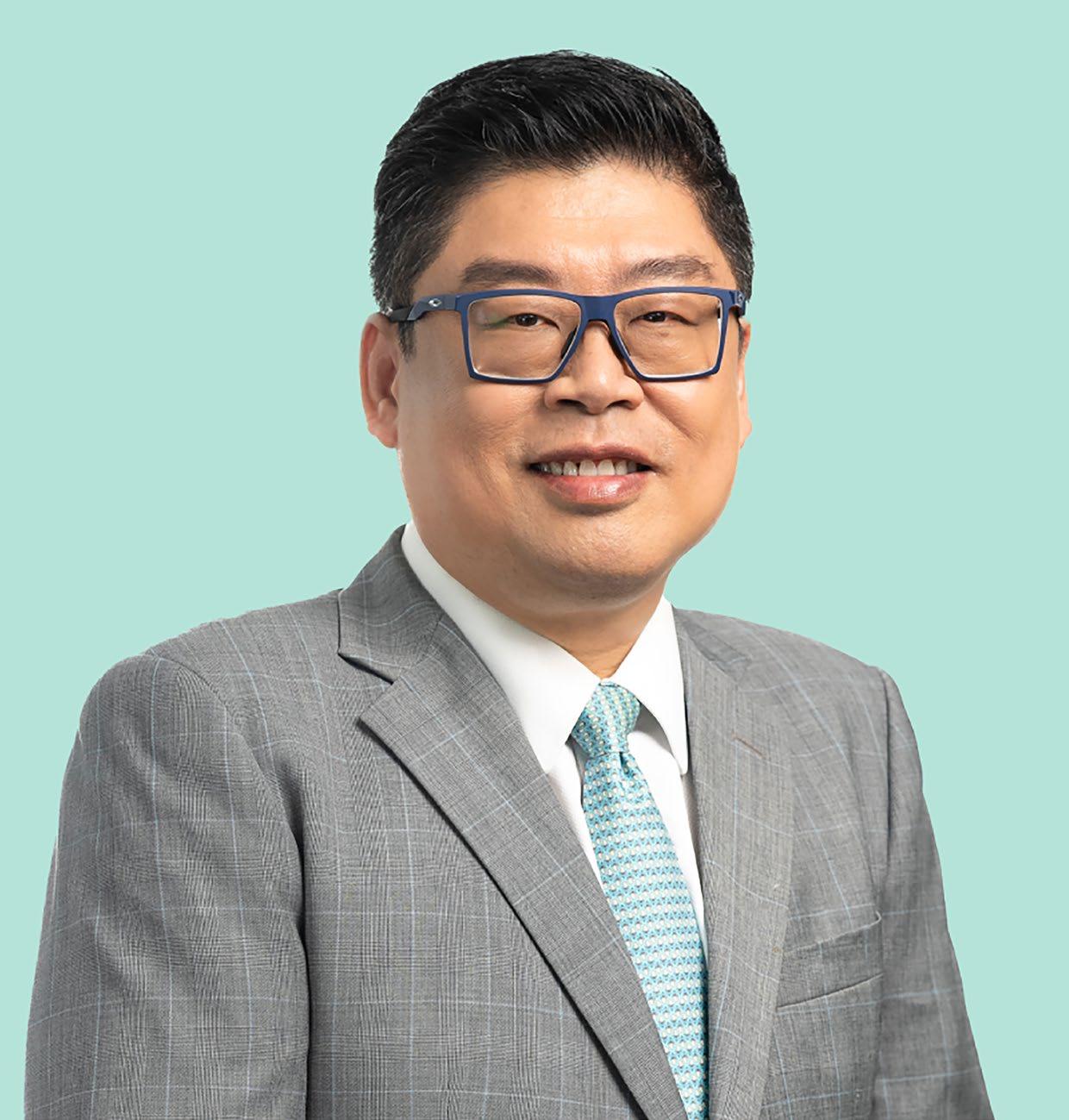
of services in one channel. “Our future app would not merely be for property transactions.”
The company’s strategy builds on the strengths of its two founding firms. Edmund Tie operated mainly in the businessto-business space, providing advisory services to institutions, corporations, and people. On the other hand, OrangeTee focused on business-to-customer transactions through its extensive agency network.
Whilst most firms focus on either business-to-business consultancy or business-to-customer brokerage, Realion offers services from acquisition and development to sales, leasing, property tax advisory, and portfolio management.
Alignment and identification phase
Amongst Realion’s key offerings is also project marketing and new launches, offering its clients a proptech-enabled, data-powered approach that supports developers in achieving strong sales outcomes.
Recently, OrangeTee has launched a new set of initiatives, including enhanced digital tools and smarter engagement platforms, to simplify client decision-making with greater control whilst helping agents deliver more personalised service. Realion is expanding regionally to Malaysia, Thailand, and Japan, and through partnerships, its reach extends to Europe, according to the company's chief executive.
Globally, the proptech market is expected to grow 11.8% annually to $103.57b by 2033 from 2023, according to Indiabased Spherical Insights & Consulting.
Our future app would not merely be for property transactions
The company is in an alignment and identification phase, assessing the combined talent pool and harmonising best practices from both entities. Sim said this process includes adopting effective management frameworks and engaging staff and stakeholders in shaping the group’s vision.


A stablecoin conversion card offers a bridge between crypto and cash.
DCS Card Centre Pte. Ltd is embracing digital asset innovation as superapps, fintechs, and blockchain technology transform the payment landscape.
“The broader payment ecosystem is undergoing a rapid shift in standards, and that is very much propelled by the rise of digital banks and fintechs,” Dayna Leng, chief marketing officer at DCS Card Centre, told Singapore Business Review in an exclusive interview.
Leng noted that the shift is not limited to traditional financial institutions.
“They're all coming up with super apps—proprietary wallets like ShopBack Pay, Shopee Pay, GrabPay, and BNPL (buy now, pay later) options even in nonfinance apps,” she told the magazine.
“All of this is moving towards creating this new level of standard for financial institutions.”
DCS, formerly Diners Club Singapore, has expanded beyond issuing credit and charge cards to include broader payment solutions and, more recently, Web3 services.
In 2024, the company launched a DCS Card that lets users convert stablecoins into Singapore dollars. This means customers can spend their digital assets directly, whilst merchants still receive payment in fiat currency.
“For Web3 community [members] who really want to have cash on hand from the stablecoins that they owned, they can do that through a physical card,” Leng said. “They can withdraw from the ATM," she added.
According to Leng, the payment space is now more fluid than ever, as digital tools blur the lines between traditional finance and decentralised systems.
“We have gone from debit to credit to mobile to digital, from operating within the traditional finance ecosystem to dual real payments across both [traditional finance] and Web3 economies,” Leng said.
This shift includes programmable tokens—smart contracts that make payments automatically when certain conditions are met. Banks like JPMorgan Chase & Co. and DBS Bank Ltd. are exploring this, and Leng sees it as a step towards better system integration.
“All in all, the interoperability between economies will continue to grow,” she said. “Consumers can expect better transaction speed and more optimal cost.”
But as digital payments grow, strong regulations are needed. “Everything needs to be regulated first,” Leng said, She added that the digital payment landscape will evolve, but institutions should ensure it stays responsible.
DCS is entering Web3 to stay relevant as the payment landscape rapidly changes. With users wanting fast, borderless payments, Leng believes digital and
Customers can expect better transaction speed and more optimal cost
decentralised tools will keep changing how money moves.
“At the end of everything, the foundation is that everything needs to be regulated first," Leng said.
"The digital payments landscape is going to evolve, but there’s going to be strong institutional involvement to enable a responsible digital lifestyle,” she continued.
In an earlier interview by Singapore Business Review, several payment firms said stablecoins could see wider adoption in 2025 as evolving global regulations create a more defined operating landscape.
“With the introduction of MiCA in Europe and expected regulatory frameworks in the US, Stablecoins are set to gain wider acceptance,” said Maxim Neshcheret, regional director for the Asia-Pacific region at Stockholmbased payment solution provider CMA Small Systems AB.
Embedded finance, where third-party financial products and services become part of nonfinancial digital platforms, will become more integrated in the merchant ecosystem in 2025, according to TR Ramacahndran, head of products and solutions for the Asia-Pacific region at Visa.
Globally, banks are also expanding their cybersecurity methods, increasing their cybersecurity spending.
The proportion appointing chief information security officers rose to over seven in 10 of banks of the 228 banks surveyed by Moody’s Ratings.
In Asia, nearly two in five or 37% of cybersecurity leaders report directly to CEOs or CFOs— a “significantly larger proportion than other regions,” Moody’s said.
Banks make use of three key advanced defense practices: penetration tests that simulate real-world attacks to identify exploitable vulnerabilities in systems and applications, with 55% of survey respondents performing them at least quarterly. Red/purple team engagements are another strategy, involving adversarial simulations that test both offensive and defensive capabilities in real-time.
This is done by three in five (64%) of large banks, and 4% of North American banks.













It is focusing on video, AI, business messaging, and digital upskilling.
Meta Platforms, Inc. is working with Singaporebased companies to help them expand overseas, as the city-state consolidates its position as a regional center for digital advertising.
“Many Singapore-based businesses are looking to go global,” Managing Director Nicole Tan told Singapore Business Review in an exclusive interview.
Meta’s role is to give them the latest artificial intelligence (AI) tools, innovations, and methods to support that expansion, she added. Eight in 10 Singapore companies plan to expand overseas within three years, according to UOB’s Business Outlook Study 2025. That push is expected to fuel demand for digital ads, which Tokyo-based ad firm Dentsu Group, expects to grow 6.3% this year.
In Singapore, Meta is focusing on video, AI, business messaging, and digital upskilling. Its short-form video format “Reels is where people are spending time, and brands can now see direct results from that engagement,” she said.
Grab used Reels to market its new family account feature, doubling ad traffic and lifting campaign performance by five points, Tan said. Globally, users share 4.5 billion Reels daily.
Video remains a bright spot in Singapore, with ad spending projected to rise 3.8% this year. Tan said Reels is also used in creator partnerships, a format popular with Gen Z consumers who are more inclined to buy through influencer links.
Meta’s strategy comes as rivals Alphabet, Inc.’s Google and ByteDance Ltd.’s TikTok also expand their ad offerings. Both are investing heavily in AI-driven targeting and video.
Tan said the Advantage+ suite allows Singapore firms to compete internationally by using AI to predict consumer needs and optimise targeting in real time.
“Businesses here want the same efficiency and reach as global brands, and AI is closing that gap."
Furniture retailer Castlery used the tools to cut cost per sale by as much as 70% whilst lifting return on ad spending by 15%. Advantage+ automates placement, audience targeting, and budget allocation, giving smaller companies global-level efficiency.
Business messaging on WhatsApp and Facebook Messenger is another priority, Tan toold the magazine, with more than 600 million daily exchanges between people and businesses on Meta’s platforms.
She also told the magazine that business messaging is becoming a conversion channel rather than a support tool, with many firms now integrating chat-based sales and payments directly into WhatsApp.
“Consumers expect direct access to brands. Messaging makes that relationship immediate and measurable,” Tan said.
To build adoption, Meta has launched training initiatives. Last year, it rolled out a masterclass series in Singapore to help companies integrate AI into campaigns.
The Llama Incubator Programme, also based in Singapore, offers six months of mentorship and resources for developing AI applications, with an emphasis on responsible practices. Singapore’s rapid digital adoption has come with risks.

Authorities recorded 19,665 scam cases in the first half of the year, with losses reaching $465.4m.
Tan said Meta is coordinating with regulators to address the issue through removal of harmful content, user reporting tools, and education campaigns.
“We are very clear on removing content that violates our policies, and we also run programmes to help people avoid clicking suspicious links or engaging with fraudulent content."
“On our platforms, users can immediately report anything they see, including ads they believe are suspicious.”
For the advertisers, Meta provides resources like the Brand Safety Hub, where advertisers can learn about the Ad Library, data transparency, and advertising policies.
Trust is foundational to growth. If people lose confidence in digital channels, everyone is affected
According to Tan, these policies are publicly available, outlining what’s allowed on the platform.
The Hub also offers tools like whitelisting and detailed reporting, serving as a central source for advertisers to understand Meta’s approach to transparency and safety.
“Trust is foundational to growth. If people lose confidence in digital channels, everyone, from platforms to advertisers, is affected," the managing director concluded.
Total visibility. Real-time tracking. Smarter freight decisions. Introducing MyHFM - HAVI’s Smart Shipment Tracking Tool

Get full control over your global shipments right here in MyHFM.
Track all your shipments live - Ocean, Air or Land. Get real-time milestone updates and delivery.
Access the system and receive instant alerts.
Designed for team who value visibility, speed and data-driven logistics.



It will benefit multinational companies reorganising for commercial or tax reasons.
Singapore’s plan to speed up the closure of dormant companies, which comes in the wake of a $3-billion money laundering case that highlighted the misuse of shell firms, could both deter unlawful activities and help companies cut compliance costs during restructuring, according to legal experts.
“A faster strike-off process—removing a company’s name from the Accounting and Corporate Regulatory Authority’s (ACRA) official register—would benefit multinational companies reorganising for operational synergies or commercial reason”, said Catherine Lim, a partner at CorpServe.
“Some subsidiary companies need to be dissolved for such restructuring to take place,” she told Singapore Business Review. “A longer strike-off process will unnecessarily impede the corporation from completing this restructuring efficiently within their desired timeline.”
Corporate restructuring is amongst several reasons companies seek a voluntary striking, said Steven Lo, managing director of corporate and finance at Drew & Napier LLC. Other reasons include winding down nonprofitable firms or closing noncompliant entities before enforcement action is taken.
“In all of these business scenarios, a faster striking-off process would allow businesses to efficiently streamline their corporate structure and reduce audit and compliance burdens,” Lo said in an exclusive interview.
Drawn-out processes
Singapore’s strike-off process takes four to six months, compared with one day for incorporation. Whilst faster than in several regional peers, it’s still slower than in Australia and the UK, Lim said.
“Speeding up this process would boost business efficiency by supporting faster closure of dormant companies,” she said. “This reduces compliance costs and administrative burdens, making Singapore more attractive to startups and investors seeking agility.”
Jayne Lee, a corporate governance partner at law firm WongPartnership LLP, said a drawn-out process raises administrative charges, logistics, service provider, and insurance costs. “Such resources could be more efficiently allocated elsewhere,” she said in a separate interview.
Kevin Ho, corporate governance co-head at WongPartnership LLP, said the ACRA itself would also free up administrative resources under a shorter process.
Changes to the Companies Act 1967 will reduce objection periods from the company for both voluntary and regulator-initiated strike-offs, whilst preserving the existing 60-day public objection period.
For voluntary strike-offs, ACRA can issue a notice immediately after notifying the company and its officers, instead of waiting 30 days.
The process can now be completed in 60 days instead of 90. In regulator-initiated cases, companies will have 15 days rather than 30 to lodge an objection, trimming the process from 90 to 75 days.

“This does not deprive the registrar from taking the time it may need to assess the application,” Lee said.




The reforms target shell companies, which the Monetary Authority of Singapore has flagged as a common tool for hiding identities and moving illicit funds.
“By ensuring that dormant and inactive companies are removed from the register promptly, Singapore reduces opportunities for such entities to be exploited for illicit purposes, including money laundering,” Lo said.
Seraphina Ho, director of Corporate & Finance at Drew & Napier LLC, added that the city-state’s 2023 money laundering case, in which foreign nationals laundered billions of dollars through Singapore, had heightened scrutiny of shell activity. “This would strengthen investor confidence and support the country’s overall anti-money laundering objectives," she said.
She said that in 2020, more than 3,000 shell firms were uncovered following investigations by the Singapore authorities pursuant to an increase in business email compromise scams. Illicit funds were funnelled into local accounts of some of these shell companies before being shifted overseas in one or two days.
“This illustrates how inactive shell companies can serve as effective conduits for money-laundering.”
A shorter ACRA-initiated process, he added, would allow authorities to shut down shell companies faster, reducing the risk of misuse.
WongPartnership's Ho said financial institutions would also benefit from more up-to-date company registers, improving Know Your Customer, anti-money laundering, as well as credit checks.
Lim said shortening the “live but inactive” stage—the period most vulnerable to exploitation—would bolster Singapore’s standing as a trusted hub.
“Making the strike-off process equally as efficient encourages more entrepreneurs to explore new business opportunities with an option to exit the market swiftly,” the CorpServe partner added.




It aims to broaden views of aviation jobs beyond pilots and cabin crew.
Aviation authorities are stepping up efforts to attract and retain local talent as the industry prepares for a major expansion, including the opening of Changi Airport’s Terminal 5 by 2030.
The Civil Aviation Authority of Singapore (CAAS) and Workforce Singapore (WSG) are developing various programmes to make aviation careers more attractive to younger and mid-career workers as part of a broader plan to sustain growth in the sector.
Angela Ng, director for aviation industry at CAAS, told Singapore Business Review that the strategy involves reshaping perceptions about aviation jobs, which many still associate narrowly with pilots and cabin crew.
“We see it as important to share with Singaporeans that there is a wide variety of opportunities available to them,” Ng said in an exclusive interview, citing the One Aviation Careers Fair held in July this year, which showcased roles ranging from air traffic management to aviation engineering and digital operations.
Automation impact
The industry employs more than 60,000 workers across airlines, airport operations, air traffic control, maintenance, and security services, according to a joint report by CAAS and WSG.
The report also highlighted that aviation’s supporting ecosystem spans food and beverage, hospitality, and travel retail services within the airport, underscoring its breadth beyond airside operations. Both CAAS and WSG said partnerships with institutes of higher learning will expand aviation course offerings and specialised training tracks to prepare the next generation for future workforce transformation.
The agencies identified 31 key operational roles crucial to sustaining Singapore’s air hub, including aircraft engineers, baggage handlers, air traffic controllers, and inflight catering professionals essential to daily operations.
Beyond hiring, retaining talent amidst rapid technological change is a growing concern. Anderson Ee, director for manufacturing and connectivity at WSG, said the sector would see major shifts as artificial intelligence, automation, and robotics transform operations.
“The priority will be for existing professionals to harness AI tools to augment their jobs and automate manual and repetitive tasks,” Ee said in the same interview.
Over the next five years, jobs that are heavily manual would see the greatest change, he added.
The shift will require extensive job redesign, reskilling, and closer coordination amongst employers, unions, and workers. Ee said collaboration is crucial to ease anxieties and ensure workers can adapt.
“Employers are encouraged to collaborate with unions and workers to co-create solutions instead of trying to take a top-down approach,” he said. “There is no one-size-fitsall approach," he continued.



Ng added that automation would also help older workers stay productive longer by reducing the physical demands of labour-intensive work.
Both officials emphasised that the Singapore Aviation Sector Tripartite Committee—composed of industry, labour, and government leaders—are crucial to coordinating workforce transformation.
To attract younger workers, CAAS and WSG are pushing “skills-first” hiring approaches that recognise transferable skills and potential for reskilling.
Ng said clear career progression frameworks and targeted training would help sustain long-term interest.
Partnerships with educational institutions are also central to the strategy. Ee said WSG works with polytechnics and technical universities to strengthen aviation-related courses and training programmes.
Structured internships and early engagement with students are meant to give prospective recruits first-hand industry exposure before they enter the workforce.
We see it as important to share with Singaporeans that there is a wide variety of opportunities availabble to them
For mid-career professionals, WSG offers career advisory services through its centres to help jobseekers understand how their existing skills can be applied in aviation. Individuals often underestimate how their experience can be valuable within the sector, Ee said.
According to Ng, Singapore’s ongoing investments— including Terminal 5 and the transition to three-runway operations—would create thousands of jobs across aviation sub-sectors.
“We have made substantial investments into our future,” she said. “With this, it's evident that more jobs will be created across all key employment sub-sectors."














MUNIZA ASKARI Assistant Professor, Economics SP Jain School of Global Management
Many small and medium enterprises (SMEs) face a recurring dilemma: how to grow without compromising the identity and trust that made them successful in the first place.
Whilst digitalisation, franchising, and investor-led scale are often viewed as the natural progression for growth, some businesses choose a different path—one that prioritises brand integrity, emotional value, and strategic restraint.
In today’s fast-paced market environment, small and medium enterprises often feel pressured to emulate the aggressive growth models of startups or multinational brands.
Yet, for many small businesses—especially those with deep cultural or community roots—such paths may be misaligned with their values, customer expectations, or operational realities.
This article highlights four key lessons that SMEs can take away from a local food enterprise that challenges conventional growth logic.
Operational consistency can enable premium pricing
In highly competitive, cost-sensitive markets like food and retail, premium pricing may seem counterintuitive. Yet some businesses maintain higher prices by investing in operational consistency. Automated processes, quality control, and centralised sourcing reduce variability and support brand trust.
When customers know they are getting the same high-quality product every time, they are often willing to pay more.
This consistency also helps reduce customer uncertainty—a powerful factor in behavioural economics—which in turn strengthens the brand’s ability to command a price premium whilst avoiding perceptions of unfairness or customer pushback.
Emotional value is strategic value
Brands that are rooted in cultural storytelling or personal meaning can create pricing power that goes beyond cost and margins. Emotional value—built through authenticity, heritage, and trust—can be a differentiator in commoditised markets.
For small businesses that have cultivated a loyal following, this emotional connection is often more defensible than scale. Emotional loyalty, once established, also insulates against short-term price sensitivity, enabling firms to weather economic fluctuations with less volatility in customer retention.
Founders often face behavioural barriers to expansion
The fear of losing what makes a business special can often weigh heavily on founders. This is known in behavioural economics as loss aversion—the principle that the pain of losing something is felt more strongly and intensely than the satisfaction of potential gain.
Many SME owners hesitate to raise prices or open new locations, not because of poor strategy, but because they worry about damaging brand identity, alienating customers, or compromising quality. These are valid concerns that deserve thoughtful attention.
Addressing these fears requires more than strategic advice—it demands founder coaching, peer mentoring, and in some cases, behavioural nudges that shift focus from immediate losses to longterm vision. Building resilience in decision-making is as much a psychological exercise as a business one.
Strategic restraint is a viable growth strategy
In an economy that often rewards speed and scale, restraint may feel countercultural—but it can be effective.
Staying intentionally small, or growing selectively, allows founders to retain control, deepen brand loyalty, and avoid overextension. For businesses with strong emotional resonance and premium positioning, scaling gradually—and on their own terms—may actually protect long-term value.
Strategic restraint also enables better demand management, staff retention, and product quality. By resisting the impulse to scale too quickly, small and medium enterprises can foster operational maturity and institutional trust—elements that often determine whether early success translates into sustainable advantage.
One such example comes from a local food entrepreneur who resisted multiple expansion offers, choosing instead to maintain consistency and control over operations.
Despite rising costs, the founder hesitated to raise prices or franchise the concept—driven by a strong emotional connection to customer trust and product integrity.
His concern was not just about profits, but about preserving the cultural and personal values the brand was built on.
His strategy may have seemed unconventional in a city known for innovation and efficiency, but it underscores a growing recognition that not all growth is healthy.
For values-led small and medium enterprises, sustainability often comes not from scale, but from strategic alignment.
These lessons are drawn from a case study. Based on classroomtested analysis, the case examines a Singapore-based food business that resisted pressure to expand rapidly or raise prices amidst rising costs. Instead, it focused on consistency, trust, and brand authenticity.
Students in executive strategy modules engaged with real-world pricing decisions, emotional trade-offs, and founder dilemmas through frameworks like the Value Stick and concepts such as contribution margin and perceived fairness.
For small and medium enterprises in Singapore and beyond, the key message is this: growth doesn’t always mean getting bigger. Sometimes it means getting clearer—on what your brand stands for, who you serve, and how to grow without selling out.
Policymakers and investors seeking to support Singapore’s SME sector should take note: behavioural insights, founder psychology, and brand authenticity are just as critical as funding and digital transformation in enabling long-term competitiveness.

When it comes to innovation in financial services, Singapore often punches well above its weight. Over the last decade, the country has transformed into a magnet for startups, a gateway for Southeast Asia’s small and medium-sized enterprises (SME), and a proving ground for what’s next in fintech and insurance.
But here’s what often goes unnoticed: whilst business-to-consumer fintech in Singapore has expanded rapidly, the business-tobusiness (B2B) side of insurance has only recently begun its own transformation – and that evolution is telling us something important about the future of commercial risk, capacity, and the often invisible infrastructure that underpins and enables enterprise growth.
We’re witnessing a quiet reordering of how insurance is discovered, bought, underwritten, and even reinsured. And Singapore, with its digitally mature SMEs and progressive regulators, is offering a glimpse of what that next chapter could look like – not just in Southeast Asia, but across emerging markets.
The distribution shift isn’t about disruption – it’s about acceleration B2B insurance has traditionally relied on one thing above all: trusted human advice. Commercial policies require context, negotiation, and customisation. Brokers have long played that role.
But the modern SME wants more – speed, transparency, and the ability to compare and customise without multiple phone calls.
Most of all, it wants predictability and control, features that don’t emerge naturally from legacy models. Tech-led platforms are stepping in to close that gap. These aren’t just online quote tools.
They’re becoming full-stack advisers, blending underwriting intelligence, sector-specific insights, and dynamic pricing. A logistics SME can assess transit risk in minutes. A digital startup can access bundled cyber products without weeks of paperwork.
This is not about cutting out brokers from the equation. It is about making advisory scalable and responsive. Platforms are reshaping how commercial risk is aggregated across the industry.
At the heart of this transformation is data – clean, granular, structured data that gives insurers and reinsurers the confidence to write risk intelligently.
Historically, small and medium enterprise insurance books were small-ticket, opaque, and volatile. But as platforms digitise and structure these policies, they’re transforming fragmented exposures into well-defined, aggregated portfolios. This is not just a win for customers – it is also a seismic shift for reinsurance.
Asia’s protection gap, estimated at over $900b, illustrates how urgently capacity needs to be reimagined. Smarter platforms, those that enable dynamic pricing and granular risk mapping, allow insurers and reinsurers to share exposure more effectively.
Suddenly, primary insurers can access dashboards showing real-time claims experience. Reinsurers, in turn, can evaluate SME books with far greater confidence. We’re no longer working with approximations, we’re working with evidence.
This also opens the door for creative risk-sharing models:

TARUN MATHUR Co-founder & Chief Business Officer Policybazaar for
Business
quota share treaties on small and medium enterprise portfolios, parametric covers for commercial property, or on-demand facultative reinsurance for fast-growing verticals. These are no longer theories – they’re becoming operational reality.
Singapore is the sandbox and reinsurers are on the front row Singapore’s unique position in the global insurance ecosystem cannot be overstated. It is home to over 80 reinsurance brokers and regional headquarters of the world’s leading reinsurers, making it one of the most important hubs in the region.
For many reinsurers who underwrite Indian risks, Singapore serves as a strategic operational base.
Even those not directly present in India often engage with the Indian market through Singapore.
This makes Singapore a crucial node for accessing Indian insurance opportunities – and vice versa.
Indian markets, with their scale and diversity, are equally crucial for reinsurers based in Singapore looking to expand their book across fast-growing emerging economies.
Both the Monetary Authority of Singapore and the Insurance Regulatory and Development Authority of India have demonstrated a strong commitment to global regulatory collaboration – actively engaging in international forums such as the International Association of Insurance Supervisors to foster innovation, crossborder supervision, and information exchange.
That’s where digital infrastructure becomes vital.
A new wave of Indian platforms is bridging this gap by building real-time digital interfaces that allow reinsurers to access fact slips instantly – without delays, follow-ups, or market visits. These interfaces are designed not just for speed but for essential data transparency, helping reinsurers assess capacity more confidently.
They get visibility into India’s fast-evolving SME insurance ecosystem and can participate in capacity-building without having to visit physical markets.
This is not just about information access – it is also about market participation at scale, powered by digital confidence.
What we’re seeing in Singapore is not a one-off trend.
It’s the early signal of a larger convergence – where distribution, underwriting, and reinsurance are connected through smarter platforms and cleaner data.
For those of us building in this space, the opportunity is not just to digitise insurance – it’s to reshape how risk itself is understood and priced. That requires credibility – not just in design, but in actuarial depth, claims governance, and capital partnerships.
It also requires a new class of reinsurers—those not constrained by legacy cycles but instead purposefully designed and architected to power and sustain this new rhythm of risk.

